#use context clues and infer what might have happened!
Explore tagged Tumblr posts
Text

#talkin#comma#this image is made regarding my previous many reblogs#use context clues and infer what might have happened!
6 notes
·
View notes
Text
thinking back to the idea of parallel instruments again: you have piano for kris and gaster, guitar for susie and dess, and music box for noelle and possibly asriel. kris:susie:noelle::gaster:dess:asriel
we could read a certain amount of parallelism in the personality traits, or possibly even the theoretical archetypes, for these characters. susie and dess might be similarly rebellious, tomboyish, and protective -- we could call these "hero" traits, in the sense of a young, plucky RPG protagonist. noelle and asriel might be similarly sweet, sensitive, and accommodating -- possibly "love interest" traits.
kris and gaster are harder to compare, given the lack of real insight into one or both personalities... though we could argue that this, itself, is a parallel. we can at least hazard a guess that kris and gaster are alike in being quiet, serious, opaque, maybe a bit "dark." we could maybe lump mischief in there, too. could we call that a bit "villain-coded"? not that kris (or gaster) is, in fact, a literal villain -- but that they have qualities one might see in a classic villain (how Byronic... lol...). it's never entirely clear what they're intending, or whether they can fully be trusted not to turn on us.
there's also the matter of cohorts and relationships. setting aside gaster for a moment: kris, susie, and noelle represent the current cohort of teens; dess and asriel are from the "previous" cohort of teens, now young adults. the latter two are both currently "missing" from the story -- asriel being away at college, dess having disappeared entirely. we can infer that dess and asriel are involved in some amount of story-relevant, pre-canon history. we might even get a sense here of something being repeated -- similar roles, new cast of teens. susie and noelle's relationship trajectory, and its priority in the narrative, might parallel dess and asriel's, as hinted by dess wearing his jacket. kris is very close to susie; we could say that susie, at this point, is kris's best friend, and likely the closest friend they've made in a long time. we can also hazard a guess, from context clues, that they have romantic feelings for susie that, due to factors beyond their control, they're unable to express or act on effectively.
so... like... what happens when we put gaster back into it? if we solve for x, if we follow the parallelism to its conclusion... what could this mean for him? sans does have at least one younger brother, name currently unknown, who isn't currently present in the story, who we might meet around the time asriel comes home...
#$ 666 mystery man lore hell#i know this is all i talk about anymore. sorry. it will happen again#honestly a lot of this is stuff i've been sitting on for a long time...#hiatus brain is like 'well nothing else to do. time to pull out the Young Gaster bullshit'
8 notes
·
View notes
Note
hi its me again ..
sorry to bother, just wanted to ask if you have any tips on how to start off a fic.. i have an idea ive been sitting on for ages and i have so much planned but i just... can't start it!! how did you start an insulting indifference...
oh man.... im so ass at giving advice.... but thank you for asking anyways! let's see.... this got long so im placing a read more
the way i write is very based on improvisation. i either go into a fic with a very very broad idea of what i want to accomplish, and let the story take me wherever it wants. if i think of something randomly that i want to write, then i go to the bottom of my word document and pound out about two to three sentences IN the moment or scene, just to set the tone. i typically end up hoarding about 3 or so pages of disconnected story moments or character dialogue. by doing this, i can also foreshadow events or make parallels that span across several chapters in the story.
work OUT OF ORDER!!! its fun!!! it keeps it exciting!!! there was one fic i wrote where the last chapter was the first ever thing i wrote for it, and so i had a better picture in my mind about how the entire thing would GENERALLY play out. i like to leave the details in the moment, which is where the improv aspect comes in. if you let yourself ride the tide of the story, you wont have to force it in certain directions as much. sometimes you have to correct its course, but mostly youre there to cruise along with the story thats coming to life!
think of it like... a bunch of big dots. and these dots are all connecting by lines. like a big web. everything in the dots are BIG STORY BEATS, and the lines are the exposition between them. the lines don't have to be straight, either. they can have loops, or wiggles, or tiny tiny dots of their own. it may not be as exciting as the HUGE dots, but its still necessary. then again, maybe it isnt! dont feel like writing a scene? skip it! trust in your readers' abilities to make inferences based on all the other context clues you give them in the text.
as you can see, i suck at giving advice HAHA. my brain is.... not very good at sorting the chaos into something tangible for others to understand.
if you have an idea, just run with it! write for the sake of writing SOMETHING. anything is a good starting point. ANYTHING. you can always go back and edit it later. write what you DONT want to write so you can get to the stuff you DO want to write.
)--)o
i would also recommend never deleting stuff youve written. if you write a scene that you end up hating, cut and paste it into a separate document just for safe keeping. it might come in handy down the line, even if you never actually USE it. you might be able to look back on it and REALIZE what does and doesnt work about it, which will improve your tone and general skills for OTHER stuff you're going to write in the future.
and one of my favorite things to do in a story when im stuck is STEP OUT OF MY BOX. especially if youre writing from a single character POV. we've been following the story of a single person, but every single other character they interact with has been going through a fanfic of their own. what is happening to them? what are they saying? being told? experiencing? what would cause them to change their mind about something suddenly? or act irrationally? the best part about writing for humans is that they're flawed. all of them. so we can write them making mistakes and doing stupid things. it helps push the plot along. it creates conflict, WHICH IS INTERESTING. we love conflict.
find something you want to write about in a fic, then expand the world around it. when i started an insulting indifference, my goal was to write about Alejandro's trauma, Noah's mental health, and have them experiencing healing by mending their relationship with not only each other, but the world and people around them. and then it grew from there!!!!!!!!!
ok im done
i talked WAAAY too much about utter nonsense. i hope at least 5% of this was helpful to you. LOL!! thank you again for the ask!!!!
18 notes
·
View notes
Note
There's something interesting about portraying torture in Minecraft. In real life, torture like what c!Q is doing would heavily disable a person for life. But since Minecraft has no mechanics to portray that well, the writers have to imply most of it offscreen. They have to focus on the psychological issues rather than the physical. Hmmm. I hope they do it well.

/rp /dsmp
it IS really interesting! Also <3 <3 syndicate!Dream, I dearly love Dream forced by physical circumstance to put aside his plans for a hot second. compels me.
I would add some caveats: despite the limitations of what’s onscreen, there are some ways to indicate permanent damage in Minecraft. Like skin changes. obviously that’s a bit harder in Dream’s case, since his skin doesn’t even have a face and is much more symbolic than literal (as opposed to say Tommy’s, which does directly reflect the appearance of his character.) And Ponk’s got the missing arm, which they continue to reference. Or it could be entirely down to what characters say, like in the case of Philza’s wings. So if cc!Dream wanted, I’m sure he could indicate some permanent physical damage. Acting, yknow. And I confess I am very much hoping for some obvious effects (even if I might be disappointed on that front.)
But something that interests me so much about torture in these fantasy contexts—ie, torture in a world where insta-healing and impermanent death both exist—is that there absolutely DOES exist a middle ground here, where horrific, physically disabling torture can be committed and mostly undone afterwards. And that ISN’T because of the limitations of what can be shown mechanically in a Minecraft game versus in a live-action genre: it’s because of how the magic system in this world works. It’s because of the story. Quackity can do absolutely brutal things, things that wouldn’t be possible IRL given that he needs to keep Dream alive, and throwing down a health potion or respawning can still restore Dream. We know his main weapons were an axe and a sword and shears. Those aren’t just unsubtle tools, those are tools where it is actively difficult not to cause huge, fatal wounds! In a world without healing magic, they’d be kinda terrible choices of torture weapons: if you sincerely hit someone with an axe a few times, they’re not unlikely to die!
(And I love how everyone has different takes on how, exactly, the mechanics of healing and respawn play into torture. Does conventional respawning hurt or not? It’s a typical mainstay of life on a server, after all. Does it hurt worse when someone else makes you do it? What can regeneration/healing potions fix? Do they make you mint again, or do bad injuries leave scars, or does it depend on how long you wait? Can they reset bones, can they regrow limbs, how much pain remains?)
And there’s HORROR there! Really compelling horror! Especially in combination with what we now know from Bad: that he saw Dream shaking post-torture—and yet, while he was able to kinda infer what had happened given all the other context clues, it wasn’t overpoweringly physically obvious. This gives us situations like Dream confronting Sapnap with his torture and Sapnap assuming Dream is exaggerating. Punz seems concerned, but not alarmed, by Dream’s appearance. The conclusion here is not that whatever happened to him must not have been all that disabling. The conclusion is that whatever happened to him has been well-hidden.
395 notes
·
View notes
Text
Adding on to your Otto Mentallis post, because I’m still in Psychonauts hype mode and can’t resist chiming in:
1: A real-world Polaroid camera has a rainbow on it (the visible colour spectrum). I figure Otto’s colours are probably meant to be the invisible spectrum, from infrared to ultraviolet. Not theory stuff, I thought it was neat, but it is sort of another connection between Otto and things you can’t see even when they’re right there.
2: I can confirm, Otto is not present at Bob’s version of the wedding: there are 3 tables, one with Lucrecia and Ford, one with Cassie and Compton, and a third with a large teddy bear instead of Otto. Helmut also has a version of the wedding in figments, but that one does include Otto. At the very least, we can be sure even from Dr. Touch and Audie arguing that Bob is not actually that fond of Otto (neither is Cassie, whose paper memory of Otto outright says that he’s full of himself, or Compton, who feels judged by him).
3: Most suspiciously in terms of something more going on, Loboto was able to break Sasha’s construct. This is something Oleander tells us never happens and requires some sort of outside help, but we learn that his employer is non-psychic and, let’s be real, most likely incapable of anything this involved by himself.
Either way, I think Otto is really fascinating. He’s right in the center of everything (bringing in Lucrecia, recovering Helmut, opening the Motherlobe), but so much about him is left unknown or vague (what’s with the pendant??) that it almost feels at times like they just scrapped his level. I also imagine it might be brilliantly subtle set-up for later.
****Above by @captainquestionart , below by pyrajanison****
These are some very good points. The last one especially, as we remember in the Rhombus of Ruin that Loboto was going to get a bonus if he ‘delivered Raz’s brain in one piece,’ which if he were talking about Gristol wouldn’t make any sense, as he has no reason to take Raz’s brain and in fact needs him ambulatory for his plan. But were we to implicate Otto, the man who is collecting a great many psychic brains, this makes a bit more sense, as Raz’s mind is that of a rather powerful psychic. The only other character we know that would want a powerful psychic brain like Raz’s is Oleander, a character whom Otto seems to have been conversing with in regards to psychic machines, like a mech with water capabilities.
One the subject of Helmut’s perception of Otto, I read one person mention that PSI-King refered to Dr. Touch as handsy, and that in Bob’s mind Otto says that the Seven (or Otto in this case) always imagined Helmut with someone taller, seemingly suggesting that perhaps Otto may have had some feelings toward Helmut before Bob and Helmut got together, and I think they may be right on that.
There is one thing I forgot to mention about Otto in my analysis that I do think is very important to his story. And that is the fact that, according to context clues, Otto may have accidentally killed someone.

In Otto’s Lab, in the list of brains that still have to be sorted, we can find a brain for a Jane Doe, who’s cause of death is listed as Brain Tumbler Malfunction: All that was left after the accident. Later in the game, once we get to Green Needle Gulch, we can find near Bob’s Green house Otto’s old lab. The lab appears to have experienced a violent explosion. Caused by what? Well when we look at where the epicenter of the explosion and scorch marks, what do we find.

An old destroyed brain tumbler. It is the only other one in the game besides the one in Sasha’s Lab and the one in the Heptadome. If we put those two details together, we can come to the conclusion that this is where that poor individual died. But who were they? And if this was where the accident took place, in Otto’s old lab, why are they listed as an unknown woman, especially if we infer that they died in an experiment preformed by Otto in his own lab? Why would he hide their identity or not know who they are? The mystery deepens. (I love that this game has such story building through details such as this)
243 notes
·
View notes
Note
This may be a dumb question, and you might have talked about it before, but do you think Billy was actually going to let Stu live after they killed everyone? I mean they obviously cared about each other, but how far did that feeling go because love is probably something that neither of them could really experience. Billy also wasn’t the nicest with Stu, especially when they’re stabbing each other; Billy stabbed him so many more times and much harder than what Stu did to him. But, at the same time, Billy was pissed at Sid and couldn’t quite go after her yet. So do you think Billy planned to kill Stu and tie up any loose ends from the beginning, or did he just go too far taking his anger out on him?
Yes and no.
if we look at everything presented within the context of the movies itself there's a clear line of things we can infer about his intentions regarding Stu near the end.
Putting shipping lenses aside, people seem to forget that Billy and Stu genuinely don't have a single positive interaction the entire movie. The closest we get is the shoulder scene, and even then Billy doesn't even react and just continues grinning at Sidney. He hits Stu and reprimands him the entire movie. Everything we interpret is subtext and between the lines. So to say Billy, in canon, cared about anyone other than himself is wishful thinking at best.
That being said, it's canon that Stu is Billy's best friend. I personally think there's no way Billy didn't care about him at all. He must've genuinely liked Stu at some point, because it can be assumed they were friends before Roman ever showed him the video. And small town settings implicitly give the feel that most people there grew up together. Now, Stu was Billy's fall guy from the get go. However, I think Billy's mental breakdown is what contributed to his emotionally shutting out everyone around him, including Stu. But before that, I like to think they were genuine best friends and enjoyed one another's company. Billy is a very patient guy, but I can't see him being friends with someone for years on end, before there's even a motive to use that person, for no reason. Like, it makes no sense. I mean I know some people do stay friends with people they don't like for years. But Billy doesn't give me that vibe. If he does to you though, the whole scenario of Billy only using Stu fits. It's just speculation at this point.
A counterargument that I see for Billy caring about Stu is that, in the OG script, Stu is described as a wannabe Billy/Billy's lackey, implying Billy only lets him hang around because he knows Stu admires him. But there were tons of things cut from the OG script, such as Billy being possibly a football player, and he definitely does NOT look like one or is implied to be one via letterman jacket or other clues. Thus, we can't really go by cut content outside of headcanon.
But, from everything we know about Billy canonically, I think that, no. He wasn't going to let Stu live in the future. Now, I don't think he necessarily meant to kill him then and there, since it's implied he kept stabbing Stu out of anger due to Stu stabbing him too hard when he explicitly told him not to. Not because he wanted to kill him, but because he was high on emotion atm. Additionally, I feel that Billy was hinging on Stu's account; it's a lot less suspicious if two people survive and they both corroborate events. but then again, Billy and Stu's plan was very flawed since the beginning, and they got away with the much simpler plan of killing Maureen, so Billy's ego could've very well have him mean to get rid of Stu there, without thinking of how he would explain what happened to Stu in the first place.
I also think Billy would eventually let his paranoia at Stu's capricious nature and proclivity to overshare take over, resulting in him killing Stu out of fear of him slipping up. We already see that he was getting upset at Stu's careless words at the water fountain, and we see that Billy is willing to hurt Stu out of anger. This doesn't mean he doesn't care or thinks he doesn't care. Billy is just a really toxic guy, I think he could be straight up in love with someone and still genuinely hurt them whether it's premeditated or not. And while we're on that topic, I think both Billy and Stu can genuinely love, the way they are wired just means that they process certain things differently/
All that being said, my headcanons and how I interpret canon are two different things. In my headcanon, and thus my writings, I see Billy as someone who not only cares about Stu, but loves him, but he suffers from internalized homophobia, specifically the unique kind that plagues bisexual(and demisexual, which is my headcanon for Billy) men (am I faking it? Am I not? Oh, bisexuality doesn't exist. It's a phase. Only girls can be bi. etc.). I don't care if it's unrealistic given his actions, or that it's implied he's straight in canon, or whatever. Because I just like to think Billy genuinely cared for Stu.
And one of the reasons I write poly ghostface is because I feel that polyamory is one of the best type of relationships he or Stu could be in. His different needs can be met by different people, it's not just hurr durr stuilly hot. If it was, I'd write every character poly and my past fandom blogs would've been poly-based as well. They're one of the few characters I actively write polyamory for - it intrigues me just how much it fits them, and it's a relationship dynamic I hadn't written before.
The beauty of fanfiction is that you can write your own universes using these same characters. And that's why I write Billy the way I do.
#stu macher#billy loomis#character analysis#i watched this movie one too many times#scream 1996#sorry for the extra info#i just really wanted to hit home why i write these characters the way i do
52 notes
·
View notes
Note
If we can infer the masks that Six acquires once belonged to previous Ladies in their youth then we can figure out their personalities based on the masks meaning/descriptions altogether: The teacup mask girl probably was too curious for her own good, Scarecrow mask girl was terrified and tried to close her eyes from horrors, Fox Mask girl was rather cunning and brave with skill in exploring, Tengu Mask girl may has accepted her fate in the end to fit in with the horrors
(Give this post a look for context!)
OMG YES! I'm so glad we're on the same train of thought, anon! Let's break these girls down and take a look at the rooms where their boxes are found as well and see if we can get a general idea of what the previous Ladies must have been like.
Teapot
Here's the official description of the teapot mask:
"Six is a natural born explorer, but bad things can happen if she peeks a little too far in. By the looks of things, she might be wearing this Upside-down Teapot a little while longer! "
Just like you said, anon, this girl must have been too curious for her own good, venturing into places she wasn't supposed to be in. I like how they drew a parallel between Six and Teapot, mentioning that they're both explorers.
The room where we can find Teapot's box, and in particular the outfit she's wearing, is quite interesting.
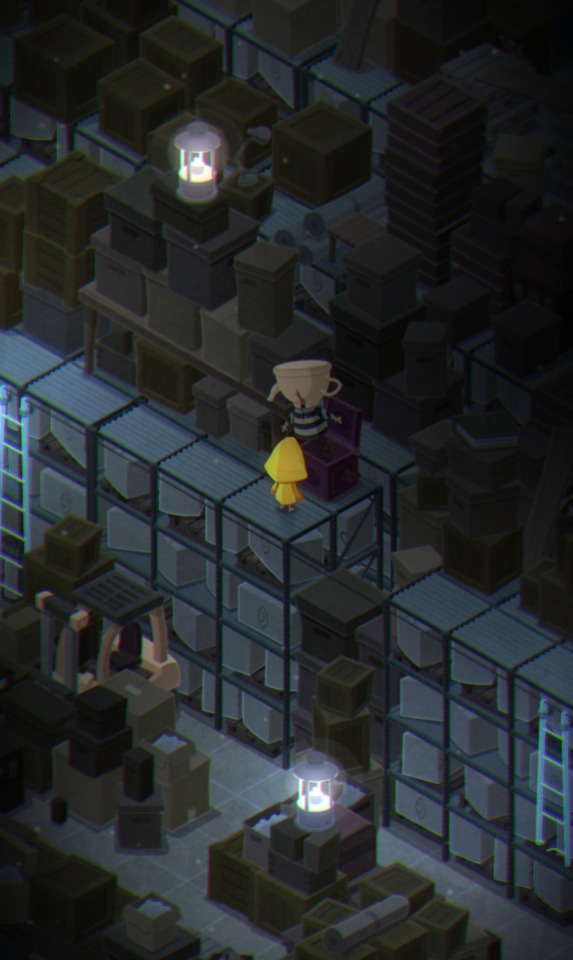
The implication here is that she probably used to be a prisoner of some sort. Plus, to reach her box we actually have to mess with the stairs quite a bit and she's literally stuck in a tiny hole between boxes. This is probably symbolic: the other rooms containing the boxes all use some sort of symbolism, so this could rappresent Teapot feeling trapped.
So to sum this one up: Teapot used to be a curious child, exploring around in places where she shouldn't have. Because of the prison motif we can theorize that she might have felt trapped once she took on the role of the Lady, a role she couldn't find her way out from.
Tengu
Tengu is an interesting one, and I can easily tell you she's my favorite out of the four. Let's take a look at the official description for her mask:
"Fear can take many forms and can live in many worlds. Wearing this Japanese Tengu mask won’t keep Six safe from harm, but it will certainly make her fit in! "
The "live in many worlds" line... possible reference to the fact that the children might come from a different dimention rather than the one LN takes place in? I'm probably overthinking this. Still, I definetely think Tengu not only accepted but also embraced her role as the Lady, unlike Teapot. The implication from this is that she did it out of fear and self preservation. You know what they say - if you can't beat 'em, join them. Still, it doesn't seem like it kept her out of harms way.
I think it's also worth mentioning that Tengu masks are used as decorations because they're believed to frighten bad spirits and bring good luck. Mh.
Moving on to Tengu's room, this one is a BRAIN SCRATCHER.

This isn't actually in Tengu's room but the one right before, I just want you guys to keep in mind that the doodles on the wall were indeed done by nomes. Moving on to her actual room, we start off pretty strong.

GIRL IF THAT ISN'T THE THIN MAN COMING OUT FROM THE TV I LITERALLY DON'T KNOW WHAT IS. Look at him, he's even got his hands in display like he does when he's about to break free in LN 2 and when he kidnaps the toddler in the comics!
He seems to be going after a group of children, the nome and his friends? The implication here is that he kidnapped them.
EDIT: OK HAHAHA SOMEONE IN THE COMMENTS MADE ME NOTICE THAT IT MOST LIKELY IS JUST AN AIR BALOON. So I probably just overanalized this (thank you for commenting btw!! I appreciated that a lot!). Still, I think the hand in the room before belongs to the Thin Man, or possibly even the Ferryman. Or even some other monster entirely. So the kids ran away from somewhere using it. I wonder if they where trying to avoid going on the Maw... mhhh. Anyway, their escape failed.
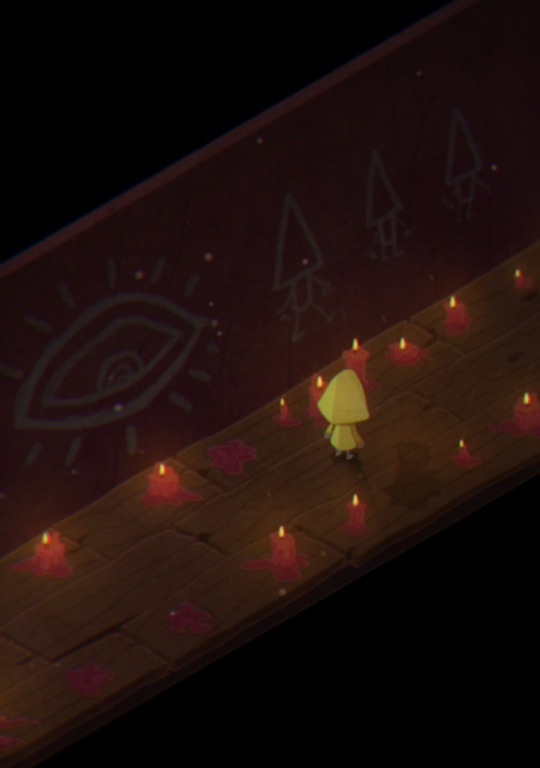
And here we see the ever present, all seeing Eye, and boom! Suddenly the children have been turned into nomes. That particular eye shape reminded me of the security eye we can find on the Maw. But what caught my attention the most is this:

Lo and behold, a tall, feminine figure, who has also been doodled on, implying that she died, right behind Tengu's box. I'd also like to point out that all the candles in the room have either melted or are about to.
This nome seems to have told us his own little adventure he had with his friends before he was captured by one of the previous Thin Men and brought on the Maw? Only to be turned into a nome by Tengu, a.k.a. one of the Ladies.
To wrap our girl up: Tengu, unlike Teapot, had accepted her fate and embraced her new role as the Lady of the Maw to the fullest in order to survive. It's also possible that she used to be familiar with one of the previous Thin Men, seeing how he's most likely taking the children to the Maw. Unfortunately, the Tengu mask did not protect her from the horrors of the world and she met her end.
Fox
Out of all the presumed Ladies, Fox seems to be the one most similar to Six, at least according to her mask's description:
" With so many nooks & crannies to explore in this unpredictable place, it takes someone special to survive. Six is as brave and cunning a character as you will find, so this Fox mask couldn’t have found a better home! "
It's pointed out how it takes someone special to survive in an enviroment like the one the LN Universe has to offer, which is an obvious nodd to Six, but I think it might also be referring to Fox herself. Now, let's take a look at the room before the one Fox's box is found. Look at the drawing on the wall.
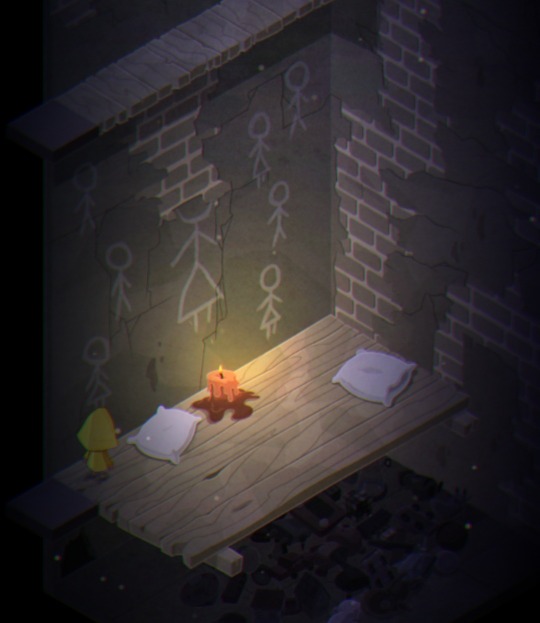
A tall woman surrounded by seven children, who match the seven nomes you have to find in order to get access to this room. Following the reasoning we used before, we'll presume the tall woman is Fox, a.k.a one of the Ladies. Note how a part of her head is missing, almost as if it got ripped away.
We get in her actual room and would you look at that.

The seven nomes, chilling quietly in Fox's room. It's very clear that they're all prefectly comfortable with bring here, see as there's one of the nomes just swinging silently on their little swing. The pillow next to Fox's box has been ripped. The implication I get here is that our girl might have gotten a little too brave and... lost her head.
I don't know about you but this feels like a memorial to me, similar to the one other nomes made for their friends a few rooms ahead.
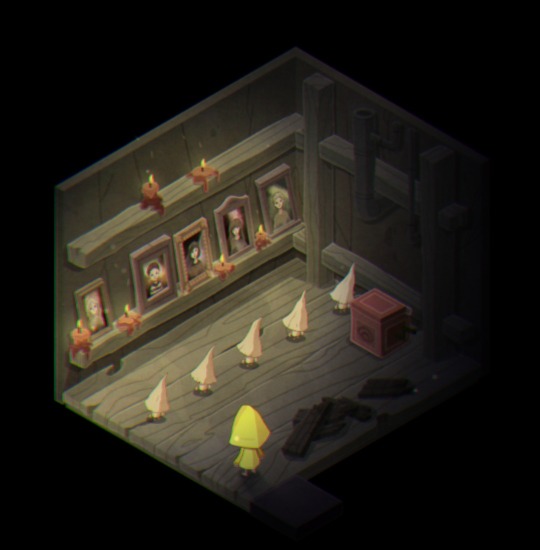
(This one. Also, the box there contains a Shadow Child figure. Definetely talking about this in a separate post.)
To sum Fox up: she was a cunning, brave, special girl, very similar to Six. Even though she most likely took on the role of the Lady, children seemed to trust her enough to be comfortable in her presence. However, something happened to her that led her to meet a very gruesome end. Possibly her successor killing her? Or maybe she was punished for being too kind to the children? Perhaps, a bit of both.
Scarecrow
There's not a lot to say about Scarecrow, if I have to be honest. Here's the official description of her mask:
" The Maw is filled with awful things hiding in the shadows and around every corner. Wear this twisted old Scarecrow Sack - it might not frighten away the monsters, but at least you won’t see them! "
Ok but let me tell you, the Scarecrow mask reminds me a lot of the sack the Hunter wears. You could say the two are similar in a way: the Hunter wears his sack to prevent himself from seeing the TVs, while Scarecrow wears hers to avoid looking at the monsters she had surrounded herself with. She most likely kept to herself most of the time, just like him.
Her room seems to suggest the same thing.

It's small, only illuminated by a small light and hidden away from the rest of the world; away from the horrors. Now, the ripped portrait of the Pretender behind her? No clue what that could mean, but see as the previous room contained a lot of portraits about the Pretender and her life? The two might be connected, or similar in some way.
Perhaps the Pretender is, deep down, just like Scarecrow was? Scared, terrified even, of the monsters around her and that's why she created her own fake little world where she can play with her ""friends"" without a care in the world? Her name IS the Pretender, after all.
Finally, the last summary: Scarecrow is a scared one, even after taking the role of the Lady she prefers to hide away into her own quarters, turning a blind eye to the horrors she (indirectly?) causes so she won't have to face them.
Ahh, this was a lot, but we got all the girls here! I really wanna hear you guys' thoughts on this one.
#little nightmares#little nightmares 2#very little nightmares#ln meta#ln theory#little nightmares theory#ln 2 theory#little nightmares 2 theory#vln theory#the lady#ln the lady#the thin man#ln the thin man#ln thin man#ln the pretender#vln the pretender#the pretender#the nomes#nomes#ln nomes#six#ln six#{should i tag the girls as well🤨#yes im tagging them#teapot#tengu#fox#scarecrow#imma draw them un the future🥰 imma keep yall updated}
129 notes
·
View notes
Text
Tangled Salt Marathon - The Alchemist Returns

Strap in folks, cause this is going to be a long one. In truth, there are very few flaws in this episode, but in order to explain them I have to really get into some character analysis first.
Summary: Varian comes to Rapunzel for help in finding the remnants of the mystical golden flower, which may hold the key to stopping the Black Rocks. Working together, they venture through the old tunnels beneath Corona. Meanwhile Cass and Eugene work together to figure out who drugged the castle’s populace with a truth serum.
Behold! The One and Only Time Frederic is Called Out on His BS; and Nothing Comes of It.

Rapunzel finally, finally stands up to her dad and points out both his abusiveness and his poor leadership. It doesn’t affect the narrative in anyway. Neither character learns anything from this nor changes their points of view. This conversation might as well not have happened given how the characters behave in later episodes/seasons.
The only reason this scene exists is to give Rapunzel motivation for stealing the flower within the episode. A goal that she changes her mind about towards the end. Thereby walking back on such motivation and putting us back at square one with her development.
Rapunzel Isn’t Being Truthful With Herself Nor the Audience
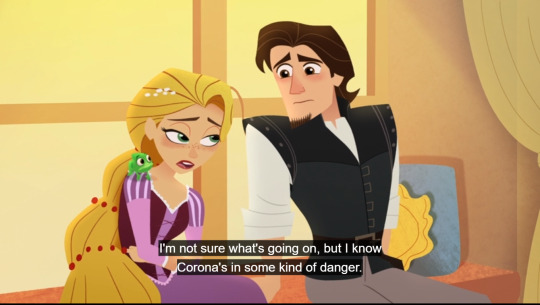

So people aren't always one hundred percent truthful about what they want and their goals. Especially if it involves admitting something about yourself or a loved one that you don’t want to acknowledge. Fictional characters are meant to give the illusion of being real so they can sometimes mimic this behavior.
Throughout the episode Rapunzel keeps on assisting that she’s doing this ‘for Corona’, but we’re given context clues along side that to tell us that her real reasons are about her relationship with her father.
Unfortunately, the show has a bad habit of not communicating information clearly and also has a history of expecting the audience to take what the characters say at face value. Ergo, it’s easy to miss Rapunzel’s true motivations and thereby fail to fully understand her actions and decisions throughout.
Once Again, These Prophetic Dreams Go Nowhere

Dream Varian mentions Rapunzel has a ‘destiny’ but the show never spells out what that destiny actually is nor why she needs to fulfill it. Sure there’s a big quest for the moonstone in season two, but the rocks stop being a threat by then so really, she doesn’t actually need to go on that quest. In fact, she would save a lot of people at lot of trouble if she did nothing at all. That’s poor storytelling. You need something driving the action; a reason to motivate the hero.
Secondly, we never get an explanation for why she randomly has these dreams in the first season but for none of the others. Nor why Varian is at the center of the them when it’s other villains she needs to actually be warned about, like say Zhan Tiri.
No, the real reason why this dream sequence exists is just to reiterate Rapunzel’s internal conflict. She wants a relationship with her Dad, but he’s a male Gothel, and she’s now caught in the middle of his and Varian’s conflict because she failed to take responsibility when she needed to. And is still failing because she doesn’t want to shatter her illusions about Frederic.
Shoving the main protagonist’s driving conflit into a subtextual dream sequence is lazy. Especially since we get no official resolution to said conflict. Rapunzel never acknowledges the problem here, never follows up on any type of action, and she never faces any true consequences for ignoring the issue.
She carries on believing in her fantasy version of Frederic, even as he continues to do harmful things, and the narrative just rewards both her and him for it.
There Should Have Been an Episode Showing the Audience Varian’s Side of the Story
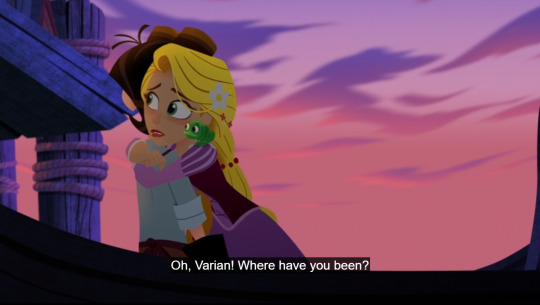
What happened to Varian in between Queen for a Day and this episode is told only through context clues. Nothing is stated outright, meaning the audience has to rely too heavily on inference and are left to piece together what happened on their own like a puzzle. That’s poor writing.
Even something as simple as ‘how much time has past’ (its three months btw, S1 is six months long and QfaD is the meant to be the midpoint) is left up to the viewer to keep up with rather then being clearly stated. This is made even harder to do by the marketing team showing most of the episodes out of order.
You need to clearly relay information to your audience. That means repeating said information in a variety of ways over the course of the story. Have those context clues, but also have more overt hints, and direct reveals interspersed along with that. Especially when dealing with the motivations and goals of the character driving the main plot.
Even if you attribute the lack of a Varain episode to the ‘twist’ in this one, (a twist that was revealed in QfaD anyways) there’s still no excuse for why we didn’t get a flashback episode afterwards to fill this hole in narrative out.
Don’t Pretend Ignorance Rapunzel


Nigel literally repeated the rumor to her face last episode. She knows her father is lying about the rocks and attacked her for the scroll. She knows from the letter that those same guards were chasing down Varian for said scroll. She knows about Corona’s laws and what would happen to Varian if the guards caught him.
There is zero reason for her to be acting like this is new information. Let alone have any right to feign concern after three months of ignoring his plea for help.
That’s what I mean about the series not communicating clearly and wanting the audience to take things at face value. The show deliberately has the characters say things that contradict established events to try and get the audience on their side.
The episode is trying to telling us, ‘See! Rapunzel is innocent in all this cause she didn’t know, but she’s trying to make up for it now’. Yet, if you’ve been watching and paying attention to the details, you know that’s not the truth here.
Good writing is about communicating ideas to your audience. But this show can’t decide on which idea to communicate. Is Rapunzel at fault or no? You can’t have it both ways. Either she screwed up and thereby caused the conflict in question now or she didn’t. If she didn’t, then events shouldn’t progress like they do. If she did, then it needs to be acknowledged and she needs to held accountable by the narrative.
More Hints into Rapunzel's True Motivation
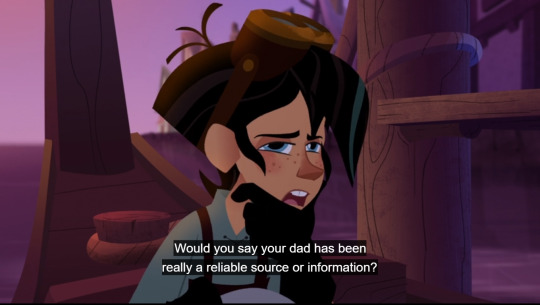

I can’t stress this enough. Rapunzel’s reasons for stealing the flower has nothing to do with Corona. That is an excuse. It’s about trying to find out what her Dad is hiding from her and why he’s lying to her. This comment right here is what compels Raps to go along with his plan.
Also...
Varian Isn’t Lying Here
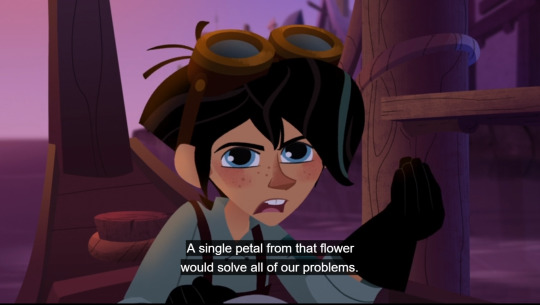
I also want to make it perfectly clear that Varian is being upfront with Raps. He tells her his plan is to steal the flower and why. She’s the one that makes the assumption that this entails them only taking one petal and the assumption that ‘all our problems’ only means saving Corona. Even though saving Corona and saving Quirin are the same problem. (more on this later)
It’s important to understand Rapunzel’s thought process and her true motivations in order to make sense of her actions later in the story.
Rapunzel’s internal conflict is her need for autonomy versus her fear of rejection. The ‘for Corona’ and ‘one petal’ excuses are used because she thinks they’ll play well with her Dad. In order words, they’re reassurances to her that should she get caught and have to face her father’s disapproval then she could counteract his arguments with his own belief system about ‘putting the kingdom’s needs first’ and ‘following your own inner voice.’
And yes, both Rapunzel and Frederic are big fat hypocrites for this, but Rapunzel hasn’t acknowledged that fact to herself and is trying to convince herself throughout the episode to believe in her own excuses.
Why Do You Care About Treason Rapunzel?
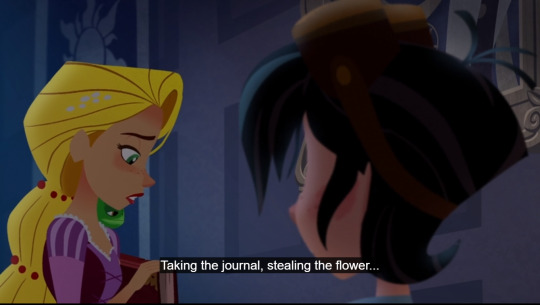

For context, treason is the highest crime in any country. It’s punishable by death, even in the real world. Now each country has its own legal definition of what constitutes as treason. Here in a America, in Article III, Section 3 of the United States Constitution, treason is specifically limited to levying war against the US, or adhering to their enemies, giving them aid and comfort. And only during a time of war. Legally, a time of war has to be approved by the US congress. Technically, congress hasn’t declared war since World War II. This is why certain people haven’t been convicted of treason like acts both in, and out of, later US conflicts because the definition is arguably too narrow and specific. But it’s intentionally that way to help prevent false accusations and to keep people in power from murdering their political opposition.
Before the US, treason just meant opposing the ruler of the land in any way. The founding fathers committed treason just by signing the Declaration of Independence. They all would have been executed had the US lost the revolution. Here in Corona, that old definition still stands. Simple theft of royal property, a non violent act, is considered treason and we already know it’s punishment. Eugene stole royal property and was almost hanged for it in the movie.
Now Rapunzel though, she is royalty. This stuff she’s stealing is technically her own property. She’ll inherit all of these things once Queen. Moreover, we all know that Frederic wouldn’t harm Rapunzel let alone kill her. She’s not in any real danger here. So why does she care?
Remember that Rapunzel’s internal conflict is personal autonomy versus her fear of rejection. She only hesitates in her pursuit of answers when reminded of Frederic’s possible disapproval. That’s why she stops under his frowning picture to say this. “Treason” only means possible rejection or disapproval from her father. The worst thing she faces is another argument with him.
Meanwhile, Varian’s life is very much at stake here. He is risking everything, quite literally, to save his father. But his life was arguably forfeit as soon as Frederic decided he wanted the scroll. What’s to prevent the king from claiming that as his own property even when it’s really not? If he’s already sent guards after Varian and the scroll then that’s precisely what he’s already done.
The series is acting like Rapunzel is the reasonable one here because she questions stealing, but the reality is she’s being selfish and willfully obtuse. Multiple lives are at stake here, including the one of the person she is talking to right now. Breaking the law, defying her father, in order to save those lives shouldn’t even be in question at all.
Corona and Quirin Aren’t Conflicting Interests.
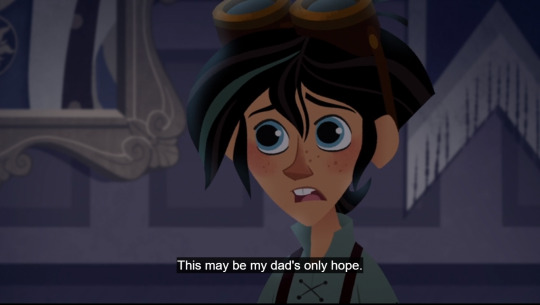
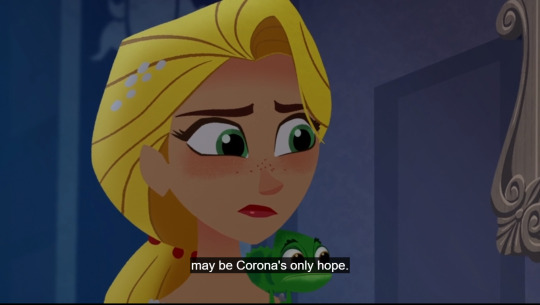

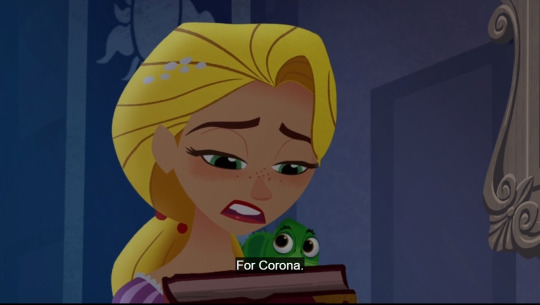
Quirin and Corona are both facing the same problem. Solving one will inevitably mean solving the other. Any distinction between the two is solely created within Rapunzel’s own mind.
She does this to to hide her true motivations and conflict from herself. The show does this to try and villainize Varian over Frederic.
There’s a clear bias in who the series wants you to root for and so it skews the perception of what’s actually at stake by creating a non-existent competition between Quirin’s life and the country’s safety. Even though Quirin, Varian, and Old Corona are all apart of the kingdom. They’re all Rapunzel’s and Federic’s responsibly too. Saving Quirin’s life should be more than reason enough to steal the flower on it’s own.
But this is ‘Rapunzel’s show’ and according to the creators, that means that her personal feelings are more important than actual human lives. Not really, but that’s their mindset and approach to conflicts in the show.
Rapunzel’s True Motivation is Revealed

So we’ve followed the hints, but here it is stated outright. This was never about Corona, the rocks,Varian’s safety, nor Quirin’s life. This is about her need for autonomy. Her own personal quest for assertiveness. She’s been bullied and abused by two steprate parental figures now and she’s growing tired of it. Which is understandable and valid, but it shouldn’t be made more important than everyone else’s problems. Everytime Rapunzel says ‘for Corona’, she really means ‘for herself.’
Rapunzel Shouldn’t be the Only Person Solving the Obstacles Here

Varian is just as smart as Rapunzel, if not smarter. This has been established throughout the show both before and after this episode. Meanwhile, Rapunzel is more physically adept than Varian. This whole sequence in the tunnels should have been both Rapunzel and Varian teaming up and complementing the other’s skill sets. They need to be on equal footing in order to sell their conflict later on. But the show deliberately down plays Varian’s competence in this episode in an effort to make Rapunzel look good.
‘Girl power’ shouldn’t mean making the character perfect. It especially shouldn’t mean making other characters weaker in comparison. Women want equality. That means we want to see female characters treated as people. That means we want female characters to be flawed while still contributing to the plot same as the male characters. That doesn’t mean we want to be paraded around as the only competent person in the room. We want to be on the same level as the boys not above them.
Over idealization and glorification of ‘strong’ female characters is just as problematic as damsels in distresses.
Writers like Chris Sonnenburg grew up during the heyday of Third-wave Feminism. Right on the cusp between second-wave and third-wave points of view as women really started to challenge Hollywood’s portrayal of themselves as homemakers and love interests. They wanted to be the heroes for once. Starting in the 60s and reaching pick popularity in the 70s and early 80s, film makers responded by making female characters who could physically fight but either failed to give them any sort of depth and/or made them the only archetype available.
Chris, and several other male writers who lived during this era, have internalized this approach by default without actually examining how it came into existence nor why women would no longer be satisfied by this portrayal of them, if they ever were. All we’ve done is trade one stereotype for another, as male creators fetishize what was once meant to be an attempt to empower ourselves.
Had Chis actually brought more female writers onto the show and listened to the criticisms from his female crew, he could have better avoided problems like the one above. But instead he dug in his heels and insisted that he already knew what we wanted. He doesn’t.
Why Would You Assume This Eugene?
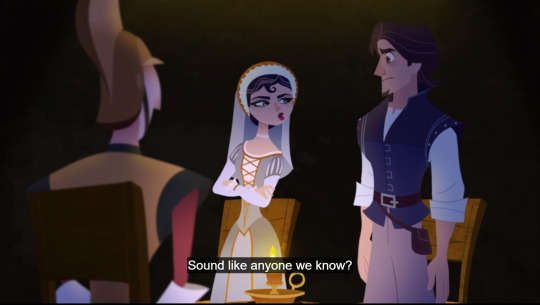


Varian hasn’t actually done anything wrong yet. His worst crimes are drugging people with a magic potion, which is what Xavier did without consequence only two episodes ago, and attempting to steal a magical healing flower that the king has been hoarding from his subjects anyways. A king who has been persecuting Varian unfairly and they know this because of Quest for Varian.
Eugene of all people should be sympathetic towards Varian’s plight. He’s been there himself. He should also know that the rumors about Varian attacking Rapunzel are untrue because Raps told him about the events of Queen for a Day herself.
Meanwhile Cassandra was actually there. She knows Varian’s problems and is supposedly his ‘friend.’ She has even less reason to be hostile towards him.
But once again, the series has the characters respond to things that contradict established events in order to create a bias in the audience. “See, Eugene and Cass doesn’t trust Varian and neither should Rapunzel. See, how evil he really is?” It tries to tell us. In order to convince us to excuse Frederic’s behavior so that when the series does just that through Rapunzel choosing his side we’ll be on board with it. You know, unless you have been paying attention, already have a developed moral code, and the reasoning facilities of an adult.
Rapunzel Lacks Empathy
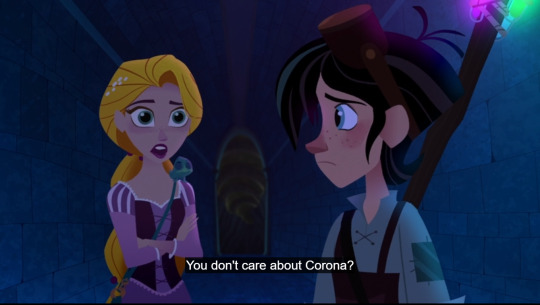
Keep in mind, ‘for Corona’ really means ‘for herself’. The only competition between Quirin and the kingdom is one that she’s fabricated in her own mind. Varian not caring about the island punctures holes into her excuses. Even though Varian is a fourteen/fifteen year old who holds no responsibility for the safety of a whole country. Especially one that’s mistreated him. Of course his father’s life is going to be more important to him.
What Rapunzel is really asking here is, “Why don't you care about what I care about?” “Why aren’t you concerned about my feelings over your own?”
Which makes sense for her character. She’s a woman who has been trapped in a tower her whole life. She lacks the experience needed to be an empathetic person. She’s never had to grieve before. The only permanent death she’s known is that of her abuser. Her trauma over nearly losing Eugene and Pascal was the fear of loss, not the actual process of living without someone. Rapunzel has no framework of reference in order to truly understand what Varian is going through.
Sympathy is feeling sorry for someone. Empathy is understanding how a person feels. Rapunzel may be a sympathetic person but she’s not an empathetic one and there’s a difference between being ‘nice’ and being kind. The show presents to us a woman who needs to learn that difference. The problem is that she never does.
This is actually a brilliant conflict and point of characterization. It’s taking what we already know about a character and expanding upon it to give us believable flaws that impact the story. I actually like this conflict. I like this portrayal. I initially preferred the series over the movie because of this.
I want Rapunzel to be flawed. I want her flaws to to inform the plot. I want to like her as a character. But I can’t. Because the show never acknowledges these flaws, never has her grow as a person. She remains unempathetic and selfish till the end even as she gains more experience, and the show acts like she is justified in hurting others.
This exchange is the quillivant of a rich person who donates money to environmentalist causes trying to shame a poor child for daring to ‘waste water’ in order to take a bath, even while ignoring their own factories spewing pollutants into the local river. The show tries to claim that classism is okay so long as it’s perpetuated by the creator’s favs.
Varian is in the Right
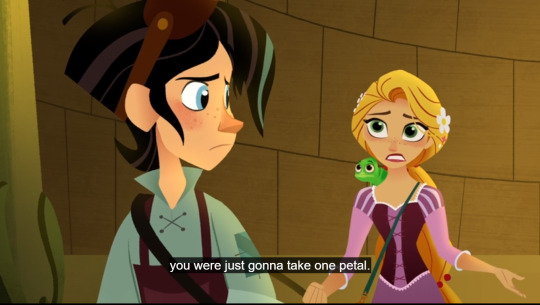
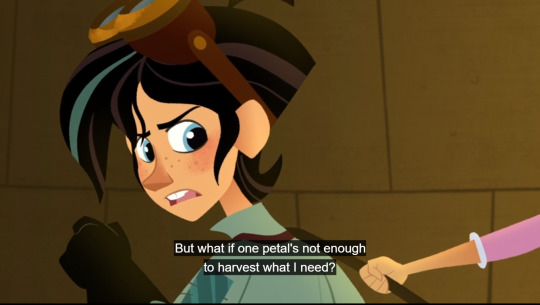
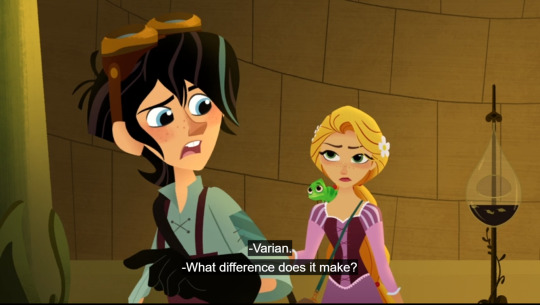

First off he never claimed that he was only going to take one petal. Rapunzel just assumed that. Also, he’s right there is no difference. Once again Rapunzel has fabricated a distinction in her mind in order to have an excuse to sell her dad. She only hesitates now because taking the whole thing means there’s more risk of getting caught and less possibility of weaseling out of punishment through deniability.
Never mind that Frederic doesn’t own the flower anyways. He stole it from Gothel first, outside of his land’s borders. Never mind that him taking the flower actually causes harm to others while stealing it back does not. Never mind that breaking a law to save a human life is not only justifiable but preferable. Never mind that the king is essentially hoarding medicine from the populace, thereby breaking the social contract of a leader towards his people and becoming a despot instead.
No, Varian hurt Rapunzel’s feelings so he’s evil don’t you see? He placed his needs above the main character’s wants and desires, ergo the series treats him as a villain.
Look, I’m not saying that Varian is without fault nor that everything he does is justifiable. But the show (and certain fans) goes out of its way to demonize the character even when he’s doing what’s actually morally right. This isn’t the point when Varian falls to the darkside, that’s yet to come, but it is the point where the series starts to play favorites with its characters at the expense of teaching coherent lessons.
Inconsistent Messages


Yes, how dare he do the exact same thing as Pascal and Max did two episodes later. Don’t you know, he’s the villain; even though he actually has more reason to use the truth serum than they did the mood potion.
The problem of centering so much of the conflict on Rapunzel’s personal feelings means that Rapunzel and the show has double standards for how characters are treated. Friends of Rapunzel gets free passes. Lack of friendship means you’re now the enemy and can’t be excused. Even though in real life that is what we call nepotism and an abuse of power.
Authoritarianism Vs Consequentialism

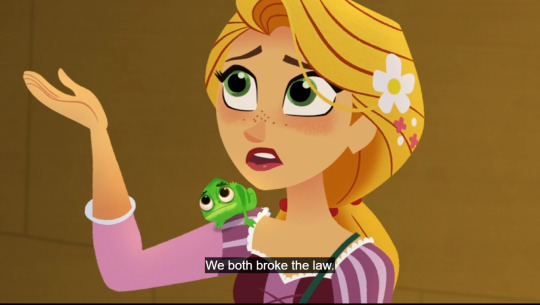
When you mention the word authoritarianism to someone they automatically picture in their head armed men in uniforms marching in the streets attacking innocent people on behalf of a dictator’s orders. Yet, that’s not what authoritarianism is. That’s fascism, which can spring forth from authoritarians gaining political power but it’s not the only manifestation of this philosophy.
Authoritarianism is the belief system that the ‘authority’ is always right, even when wrong. An authoritarian will find any excuse to follow and believe in their chosen authority even when that authority has failed them or others.
The opposing philosophy here is consequentialism. That’s the belief that right and wrong are directly linked to consequence. To their minds something is morally wrong if the action has a bad outcome for others.
To illustrate the difference let's look at a near universal rule.
“Murder is wrong.”
Now both the authoritarian and the consequentialist will normally agree with this. But the ‘why’ to them couldn’t be any more different.
To an authoritarian ‘murder is wrong’ because the authority has deemed it so. That authority can be anything that the anthoritian has personally chosen; God, the government, their parents ect. It’s completely arbitrary and subject to change on a whim. The authoritarian lacks consistency and conviction and will often have multiple chosen authorities that will contradict one another. If one of those authorities came out in favor of murder then there’s a strong chance that the authoritarian will change their position or belief as oppose to denouncing their chosen leader.
Meanwhile, ‘murder is wrong’ to the consequentialist because there are clear irreversibly bad consequences for doing it. It removes a life from the world. All possibilities for that person are now forever snuffed out. It hurts those left behind. ect. The consequentialist is consistent in their beliefs so long as the consequence remains the same. They can’t be swayed by mere orders. That’s not to say that consequentialism is incorruptible. A consequentialist can easily become a knight templar if they are forced to weigh consequences against each other. Then it becomes ‘murder is still wrong unless it achieves this arbitrary goal’.
In truth, morality is a sliding scale for most people and you normally hold more than one ethical belief system. However history has proven that authoritarianism is the more often dangerous and corruptible philosophy as it relies heavily on peer pressure, groupthink, and yes, abuse. Most authortians don't come from healthy loving homes. Either they were abused or are abusers themselves. When conducting studies on authoritarianism psychologists and sociologists use questions about parenting in order to pinpoint who is and isn’t an authoritarian as most people aren’t going to just come right out and claim we should go back to feudalism and the divine right of kings.
An out of control authoritarian is a bully with power. An out of control consequentialist is just a vigilante.
Frederic and Varian are the representatives of the two sides of these opposing belief systems and the representatives of what happens when people with those belief systems become corrupt. By having the main character choose between the two of them and siding with the her father, the authoritarian, the show is now validating this philosophy.
Breaking an unjust law shouldn’t be presented as a bad thing here. Blindly accepting Frederic’s rule shouldn’t be the end result of all this. Excusing his abusive behavior shouldn’t be the finale outcome of the story. There’s not a single thing that Frederic, and by extension Rapunzel, does that hasn’t been done by corrupt governments in the real world. Their reasons for doing so be damned.
Given the current political landscape and the increasing push to give real life anthortirans more power, this was absolutely the wrong message to put into a children’s show. It’s not that children will grow up to become authoritarians themselves by just watching the show, but it can condition them to go along with authoritarian abuse if they are now familiar the excuses abusers use to validate their actions. Especially, if they are already trapped in an abusive environment and are being fed these excuses by their current abusers.
I've already seen this toxic thought process played out by younger members of the fandom who are only just now forming their moral codes. “Accept what’ve you’ve been given.” “It’s okay, your parent (the authority) loves you and knows what’s best” “Hurting people is alright because they’ve been hurt you need to ofter up understanding”
NO!
Theses aren’t good lessons. These are the lies fed to you by abusive people. And the show repeatedly validates, justifies, and excuses both abuse and political corruption. Whether the creators believe this philosophy or not, they just approved of it anyways through their own incompetence.
Varian has Every Reason to Not Trust Rapunzel


This the third time in three months that Rapunzel has backed out of helping him. All for increasingly flimsy reasons. She’s making a lot of promises here but not offering up any concrete solutions. Remember she’s not ready to confront her father yet, and neither of them know that she’s the sundrop herself. So what is her plan here? How is she suppose to recuse Quirin and prevent Varian from being unjustly punished if she can’t stand up to the one person who is responsible for causing these problems in the first place.
Can you really blame Varian for going through with what he does here given how she has treated him thus far and would most likely continue to treat him? Yet that’s precisely what the show wants you to do because ‘stealing is wrong’ even though in this case it actually isn’t.
This is Out of Character

Once again, both Cass and Eugene have no reason within the current narrative to be so hostile towards Varian, yet. They’re only doing so now to create bias in the viewer. For Eugene this is especially out of character. I mean we’ve already seen Cass place her ambitions of above others people’s needs both before and after this, but Eugene is constantly written as the heart of the show. He’s suppose to be the most empathetic and caring person in the group, and yet here he is trying to arrest an orphan who’s only stealing to survive. Sound familiar? He of all people should be the first to defend Varian not attack him.
Excuse You, Raps!
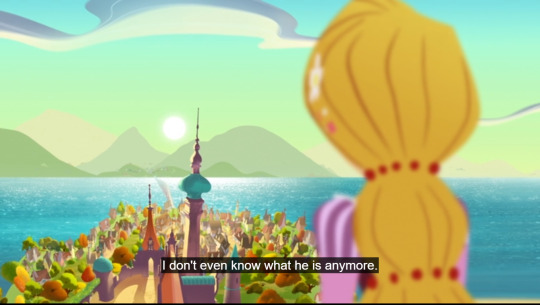
You know very well what he is. He’s a child. A lost, lonely, grieving, and desperate child who’s been let down by everyone who is responsible for him including yourself. But far be it for the show to actually point this out by stating it plainly and show you for the self centered ass you really are.
Scenes Like This are Why Varian Should Have Been the Deuteragonist
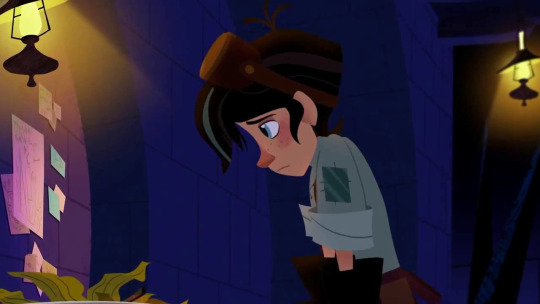
His story maybe connected to Rapunzel’s but it doesn’t revolve around her. He has his own stakes and conflicts that happen to intersect or oppose with Raps given whatever point in the narrative we’re at. As such we gets scenes like this one in his lab where he is the sole focus and is pushing the story forward. No other character actually gets this.
Eugene’s arc has little to no bearing on the overall plot and Cassandra’s solo scenes in season three do nothing to further push the story nor give new insights into her character, as her given goal and motivation is too dependent upon Rapunzel herself to be shown separately.
Out of all the main characters, Varian’s conflict is the only one that holds enough tension to maintain a separate story line. He needs this focus in order to make sense of what's going on with the larger picture and to resolve his conflict in a satisfying manner. Had the the creators been smart enough to follow through with Varian’s story till the end instead of dumping it at the last minute in season two and hastily rewriting a half-arsed resolution it in season three, then we’ve could have gotten the Disney equivalent of a Zuko vs. Aang, Loki vs Thor, or even Duck vs Rue/Fakir arc. As is, we’re only left with the table scraps of several loosely connected stories none of which are very satisfying to watch.
Conclusion
I still like this episode and Varian’s arc overall but I can't in good conscience call it well written knowing now where it all leads to. Nor can I in could good conscience recommend the show knowing the awful morals it touts. And that makes me angry. Angry that I was fooled into thinking that this show had depth and maturity. Angry that I ever once held this show up as being good. Angry that I invested myself into believing that this show would finally give me a decent Disney anti-villain that I could like. Angry that trusted the creators not to be raging arseholes who made poor creative decisions based off of ego and questionable ethics...
I started this marathon so that I could vent my feelings and gain some closure, while also opening up a frank discussion about how bad creative decisions can lead to bad lessons in children's media. This show has many of the same problems as a lot of current tv series do but all condensed down into one place and there are things to be learn from that.However after this series of reviews are over I doubt I’ll ever watch the show again. It’s honestly not worth the time.
#varian#rapunzel#anti-tangled#anti-rapunzel#tangled#tangled the series#rapunzel's tangled adventure#review#character analysis
210 notes
·
View notes
Text
Neon Genesis Evangelion analysis chapter 10 Eva Unit-01 Clone of Lilith

Mankind’s ultimate multipurpose decisive weapon, the synthetic human Evangelion Unit -01
Before we dive into further analysis, I would like to thank you for your patients. Covering the Human Instrumentality Project is the most important subplot in this series thus it was necessary to cover it in detail before all else. Of course, some things were left out due to it requiring an understanding of other settings we have yet covered. But I can promise you that nothing will be as dense and convoluted as HIP has been. Now let us return to the beginning and begin exploring other subplots of the series. To start things off, let's talk about the thing that most people associate with when we talk about Evangelion. Eva Unit – 01; the test unit.
Evangelion Unit – 01 refers to the test type model build in Gehirn’s Hakone base and is set apart from other Evas as having built out of Lilith’s body. This fact being a top-secret that only the highest-ranking officials of Gehirn were aware of. Its main purpose was to be used to fight off the angels when they began their advance. Because it was Ikari Yui who directed the E-project during its development, the idea of using Lilith in its development was likely her Idea as well. Due to this fact, Seele refers to Unit 01 as “Lilith’s clone”.

Protecting her son from harm
Simply from looks alone, unit – 01 is not different from other Evangelions based on Adam, but its behavior, especially the numerous times it went on a rampage, shows that it can function (perhaps even better) even without the necessary power supply. Even before it consumed Zeruel’s S2 engine, Unit – 01 was able to ignore the assumptions people had of it (Even in its first appearance, it moved on its own; without having a pilot). Considering how for Unit – 00, its rampage happened out of anger (To be covered in the following chapters) and Unit – 02 only doing so at the very end; before its death, it is the only Unit that went on a rampage to protect its pilot.

Of course, those who have watched the series would know the reason. In 2004, Yui’s soul was absorbed into Unit – 01 during the contact experiment. Considering that the construction of this Unit was complete in 2014, she waited a decade all alone until her son, Shinji began piloting Unit – 01. Furthermore, this unit received the most care from Gendou because it contained the soul of the love of his life, not to mention the role it was to play during the HIP.
But, let us put the discussion of the Core, Yui’s soul, and the pilot Shiji aside for now (I promise we will get back to it). For now, we need to discuss Lilith since, while Unit – 01 contains Shinji’s mother’s soul, it is built from the body of ‘humanity’ mother.

The mother of all humans
Lilith is often referred to as the second angel. But due to her being of the same status as Adam, some argue that she should also be referred to as the First angel. There are also some voices in the community that refute her (and Lilins’) categorization as an “angel” at all. But as our characters in the series refer to humans as the “final angel”, and the fact that the numbering of angels appears to be in the order of them reaching the earth, the designation seems apt.

Let’s look at how Lilith physically looks
She’s about the size of the Evas but is missing her lower half of the body, and in place, there are growths that look like legs; of human size.
This design is what clues us into the idea that humans have come from her

Let us also look at her mask.
The mask is purple in color, is made out of unspecified material, and has what seems like Seele’s insignia, although it is not known whether the mask existed and Seele modeled their insignia after it, or if Seele placed the mask over Lilith’s face.

Now out of favor, there used to be a theory that this blue hair was supposed to be Unit – 01’s soul.
There is something many people tend to gloss over in discussions on this series, and it is the scene at the final part of the End of Evangelion where we see Unit-01’s real hair, and close inspection of it shows us that it is of the same tone as Rei’s, this represents an existing connection between Unit – 01 and Lilith. Through this, we can also explain why Rei’s hair was blue, even though she was cloned from Yui, and allow us to infer that while salvaging (capturing) Lilith’s soul, some of her DNA was passed into its vessel, Rei.
We can also come to the conclusion that Gendou did not, in fact, have an anime Waifu fetish and made Rei dye her hair.

But the question remains, why was unit – 01 made based on Lilith? In truth, even if we say that it was ‘Lilith based’, we are not given any clue to what it actually means until the latter part of episode 23; when Ritsuko destroys Rei’s clone bodies.
But you might not have seen this before. It is not because it is difficult to see… I mean, it is, but it is because Evangelion has gone through multiple edits and retakes. There was the original TVA, then the following uncut VHS or the “complete version”, and the 2003 remastered version. The versions that we can find easily are the TVA and the 2003 version.
The following will be a discussion on the uncut VHS “complete version”. The remastered 2003 follows exactly the uncut VHS except for some little difference in this scene.

The decision to not use this sequence is likely due to how difficult it is to make out what is happening on screen.
Behind the Rei clones floating around in LCL, we see multiple frames that overlap it. I mention this here due to the importance of those images and what it depicts.

This is what we get if we put them together

It looks just like this picture that is from the Evangelion artbook
You should get the gist of what I want to say here. They placed the picture of Lilith being dismembered to create Unit – 01 and overlaid it with the scene of Rei clones. This tells us that Unit – 01 is not just a mere clone of Lilith, but that it can be considered Lilith’s flesh and blood; Lilith itself.
This also explains why the lower half of Lilith stays in its incomplete form for the vast majority of the series. The amount of damage done to the body would require a great amount of time to heal.

Lilins are the scariest
There is no argument that Lilith is the mother of all humans, yet Seele and Gehirn (Nerv) do terrible things to her. They cut off large parts of her body with the excuse that it is needed to create Unit – 01, nail her on the cross, and use her blood (LCL) for experiments and use in battle. To top it all off, Seele’s plans involve using her as the sacrifice during the ritual that annihilates all of her descendants. Not to mention restraining her by the method of planting the Lance of Longinus in her chest for the sake of “Waiting for the right time”!

Many see Kaworu’s action in episode 24 and during the end of Evangelion and praise his acceptance of Lilins, who illegitimately took the planet that was rightfully his. But I believe we can also view Lilith in a similar light. Even if her descendants are ashamed of her, without saying a single thing she gives like the giving tree. Perhaps that is why she symbolizes motherhood in this series
*Do please note that this was written in the context of a more traditional view of motherhood
TBC Chapter 11: Eva Unit-02 Mother of Asuka
#Neon genesis evangelion#Evangelion#Eva#End of evangelion#Nge#Nagisa Kaworu#Lilith#Sci-fi#Ikari Shinji#Soryu Asuka Langley#asuka#Ayanami Rei#rei#Anno Hideaki#Katsuragi Misato#Anime#Analysis#Review
61 notes
·
View notes
Note
1/2 Maddie keeping the secret from buck wont have been easy at all for maddie to do, she in an impossible position, probably worrying whether it was the right thing, if its crueler tell him and or to keep it. But she wouldnt keep buck from knowing/meeting the person the secret involve so ie if adopted they're died when he was a baby, she wouldn't keep a living person from him) Only wanting to protect buck but as bucks sister she shouldnt have been put in that position, telling or
2/2 keeping that secret should only be the responsibility of their parents. It does sound seem like maddie tells chimn with the line "Its not you I'm trying to protect" and chimn struggling to keep all the secrets when they arrive. But I dont think maddie even if she tells chimn she will have told him lightly or even on purpose, she probably needed a new perspective from someone who knows buck but isnt involved.
You have made several points and let’s talk about them!
So yes, Maddie is in an impossible situation, but I would also like to make it a point that whatever the secret is has to do with their childhood. soooo Maddie was a child too whenever this was going on. Whatever she knows she’s held onto for this long, don’t care if you wanna argue she was a teenager, she was older, whatever. she was a minor, whatever happened to them, they were both children and Maddie should not be responsible for handling whatever this is we’re talking about.
Now I will say that I’ve been on the fence about the whole adoption thing, I don’t think that’s it anymore... I mean it could be I suppose. I suppose we could still be dealing with a situation where maybe something happened to “real” parents, and they’ve been adopted, one or both of them. and maybe that is what we’re looking at. I’ve personally been leaning more towards maybe another sibling. I’m not completely sure, to be honest, there is plenty of merit with both of these theories. but like these are all just theories at the end of it you know. we still gotta wait 2 more weeks to find out for sure and it’s killing me!!!!!
Maddie is seen saying she’s trying to protect someone. we don’t know for a fact it’s Buck, but I think most of us have made an inference that it’s Buck. But I’d like to just make it clear that Maddie doesn’t say it’s Buck she’s trying to protect.
But We know that Maddie has done nothing but protect and care for her brother since we’ve been introduced to her character, and we know that even before when they were younger, we’re given plenty of context clues to make, at least me, feel comfortable saying that Maddie’s always put her brother’s care and well being above any trivial thing and that she would do anything within her power to protect him.
now. Maddie should have never been put in a situation where she was meant to be telling or keeping secrets. you said it Nonnie and you are correct! whatever the secret is, is not Maddie’s responsibility. It is the responsibility of their parents. We need to be looking at and asking why the fuck their parents aren’t telling Buck whatever it is, and asking ourselves what could be so serious that Maddie feels like she needs to take it upon herself right now, to tell Buck whatever it is, when she should not be having to deal with whatever this, but bc their parents are choosing not to, so Maddie is taking responsibility and taking it upon herself when it really should not be something she has to do.
so like idk what to think about the Chim stuff. part of me thinks okay she could have told him. part of me thinks that maybe the secret isn’t even about Buck and that we’re maybe taking the Chim part of it out of context. like the “protecting” thing might not have anything to do with Buck. we have not enough context, or any context really for these lines. so I can’t even really speculate on this part of it if we’re gonna try to apply it to the childhood secret bc we don’t have the context to do so properly. and yeah it’s all speculation at the end of the day but like this is getting sticky.
#Bri screams#911 spoilers#9-1-1 speculations#anon#The Evan Buckley Saga continues#The Buckley Siblings Saga continues#some of y'all really out here acting like Maddie is a bad person/sister for keeping a secret from Buck#she was a child herself so stfu#this is not her responsibility she's doing the right thing#we accept no Maddie Buckley slander here
7 notes
·
View notes
Text
Those Who Wish Me Dead Ending Explained
https://ift.tt/3uOt7K3
This article contains Those Who Wish Me Dead spoilers. You can read our spoiler-free review here.
What’s on the piece of paper? Why exactly do Aidan Gillen and Nicholas Hoult want this Connor kid dead so badly? The ending of Taylor Sheridan’s Those Who Wish Me Dead is purposefully vague about what all this killing was about. But as a news crew approaches the young lad, played by Finn Little, it becomes clear he is going to tell a story that a lot of shadowy people wanted to keep hidden.
So what is that story and why did so many people have to die for it? The exact details remain hidden, but if we look at the whole structure of the movie, there are enough context clues to have a pretty good idea of what all the dying is for.
It goes back to the beginning of the film where we see Gillen’s Jack and Hoult’s Patrick pass themselves off as local gas and fire authorities in Florida, ingratiating themselves with the wife of an off-screen district attorney—he’s in the shower—and presumably killing both before planting the bomb. We aren’t shown that they physically murder the couple either, but writer-director Sheridan relies heavily on inference throughout the picture. Case in point: Jack and Patrick debating whether the latter needs to go change his shirt because there is a drop of blood on it. This strongly suggests that they killed everyone in the house, even before the explosion.
In the same vein, you can also hear a baby crying off-screen when Jack and Patrick first enter the DA’s home, which means when Patrick later tells Ethan (Jon Bernthal) he won’t kill him or his wife Allison (Medina Senghore) because she’s pregnant, he’s lying through his teeth. In fact, Jack picks going against the shooter at the end over Angelina Jolie’s Hannah because he’s furious about getting the whole Two-Face treatment with the fire to the face earlier in the movie, and he hopes Allison is holding the deer rifle in the woods.
Conveying motivation through implication applies to most of the characters in Those Who Wish Me Dead, and what they’re dying over. When Connor’s father Owen (Jake Weber) sees on the morning news in Jacksonville, Florida that the DA he worked for died “in a gas leak,” he immediately goes on the run with his son, getting farther than the men who wish him dead could have anticipated. And he gives us just enough to know why he is so scared with his confession to his son.
“I’m a forensic accountant,” Owen tells the boy, “which means I look for things that don’t add up. And I found some. The man I worked for, he was killed today because of what I found. But I still know it, which means they’re gonna come after me too.” When his son protests they should go to the police, Owen insists that the police protection didn’t save the DA. “The case implicates a lot of people, son, people with a lot to lose. Governors, congressmen. We can only trust people that we know.”
It’s a wise choice, although trusting the family that he knows is exactly how Jack and Patrick find the father and son so easily. After breaking into the accountant’s home, Patrick coolly spies a family photo of the pair in Montana with Uncle Ethan and Aunt Allison, thereby knowing they’re going to Soda Butte Survival School in Montana. The killers get there by plane long before Owen drives to his doom on the Lewis and Clark Trail.
Still, from what little Owen tells us, we can ascertain that he is an accountant who specialized in tracing money laundering, embezzlement, fraud, and the type of racketeering where organized crime and politics intersect. While we’re never told which politicians are implicated, it’s a fair bet that there are many in the Florida area caught with their hands in a violent, possibly treasonous cookiejar. One is even tempted to speculate it could involve a former president with a Floridian residence (notably Those Who Wish Me Dead was originally due out in 2020), but that is perhaps just imaginative thinking.
The full weight of the menace, however, is exemplified by Tyler Perry who has a tantalizing cameo as “Arthur,” the laconic heavy who makes an unexpected appearance in Montana to apply pressure on Jack and Patrick for failing to kill Connor in the car wreck. We don’t know a lot about Arthur, but the way he says “we promise absolutes, and unlikely is not an absolute” seems to suggest he’s a crime boss of the highest order.
Yet the way he doesn’t even want to be seen on the same road as Jack and Owen’s car—having Jack be dropped off in a parking lot and walk over an interstate for their roadside chat—suggests Arthur is someone more public than even that. Perhaps he works in a political office, or is at least a fixer hired by one. He provides a brutal form of clean-up and discretion to people in power, while exerting his own influence over them. “I will make them have the stomach for it,” Arthur tells Jack about the prospect of killing a lot more innocent people in this small Western town.
Thanks to Perry’s one scene, we also get a strong idea about why it would be so dangerous for people in power if even Connor with a blood-stained note can get in front of a media camera. He’s more than just a witness to his father’s murder, and a mouthpiece for what might be by then unsubstantiated claims from his dead old man. Arthur explains exactly what’s in that note for us.
“[Owen] was resourceful enough to make it all the way here,” says Arthur, “so assume he was resourceful enough to have duplicates of everything we retrieved from the DA’s office, and assume the duplicates are in the possession of that boy. Assume the worst case scenario, assume catastrophe, and act accordingly.”
While we know the boy is only carrying a note, the note could plausibly include the location of those duplicates, as well as the names of powerful politicians who are implicated. After all, it would take a very big name, at perhaps the highest level, to get Jolie’s Hannah so spooked. She went from trying to convince the child to spend the night in her watchtower to saying, “We’re leaving right now” after glancing at the paper. It appears Owen found the smoking gun, and now it’s firing directly at him and his.
Read more
Movies
Spiral: From the Book of Saw Review – Chris Rock Caught in Same Old Traps
By Don Kaye
Movies
The Woman in the Window Review: Netflix’s Hitchcock-lite Is a Couple of Years Too Late
By Rosie Fletcher
So young Owen getting on television and sharing his truth with the world will likely have profound implications, creating a situation that is, in Arthur’s words, “untenable” for those who wish the kid dead.
With that said, the truth is we never have to know the full details. The point is conveyed quickly and clearly with that first gas leak explosion in a rich suburban neighborhood: this is information of the most explosive nature. And in truth it is a MacGuffin that gets us into the movie’s conventional thrills about Jolie versus Hoult in a burning forest, with an axe between them.
Alfred Hitchcock popularized the term “MacGuffin,” to refer to the object or plot device which incites the tension and intrigue of a thriller. He also famously shrugged that the MacGuffin is nothing.
“The best MacGuffin is the one that 30 minutes after the movie is over, you have no idea what it was,” TCM host and novelist Eddie Muller once told us. “To me, that represents the essence of the MacGuffin. It’s like you remember everything that happens in the story, but you have no idea what it was that they were after. ‘Like, what was that again? I can’t remember!’”
cnx.cmd.push(function() { cnx({ playerId: "106e33c0-3911-473c-b599-b1426db57530", }).render("0270c398a82f44f49c23c16122516796"); });
So while it’s fun to speculate just how damning that little piece of paper is, what you’ll probably really remember about Those Who Wish Me Dead, if anything, is Jolie’s silhouette surrounded by flames, or the tension of Allison blowing more than smoke in a couple of hapless killers’ faces.
The post Those Who Wish Me Dead Ending Explained appeared first on Den of Geek.
from Den of Geek https://ift.tt/2RRBAgM
2 notes
·
View notes
Photo
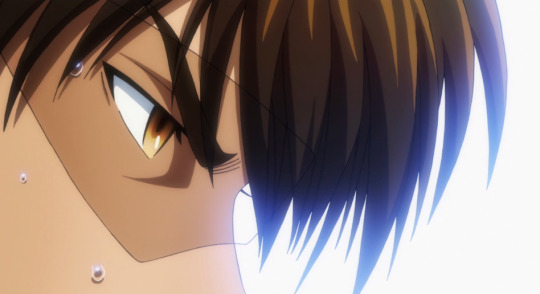
Miyuki and Eijun’s Yips...in Miyuki’s own words.
I see this subject come up time and time again, and I have some time on my hands, so I really have to talk about Miyuki’s role in Eijun’s recovery from yips. Sorry folks. It’s just that people often say he didn’t have one, and IMO that’s not the case. This might be long, so read it at your own risk.
I admit, I don’t buy into the idea Eijun’s yips are caused or aggravated by Miyuki, because we’re shown Eijun’s trauma after the Inajitsu game (the hit-by-pitch, seeing Tetsu cry, etc) and during the Yakushi game (when he feels pressured by Furuya and Kataoka’s comments about being a relief pitcher). It doesn’t matter if Miyuki blames himself - it’s not really logical that his criticism (which Eijun has dealt with from the start) should play a bigger role than the two traumas mentioned already. But even if we exonerate him from causing the yips, what about Eijun’s recovery?
As a language geek and a literature major, allow me to bore you all to tears elaborate. Let’s take that scene when Kataoka, Miyuki and Chris are watching Kariba, Kanemaru and Eijun practicing the outside pitch. Let’s look at what is actually being said in this scene, because I think it’s really important to understanding what’s really going on here.
Miyuki’s exact line is as follows:
Su’imasen, Chris-senpai ni made dette kite moratte.
(すいません、クリス先輩にまで出って来てもらって)
Believe it or not, this simple sentence actually gives two important clues about Miyuki’s involvement post yips.
Clue #1 - Receiving a favour. The use of suffix verb moratte (morau) indicates the receipt of a favour from Chris to Miyuki. In other words, Chris getting involved was on Miyuki’s request. Of course, that alone doesn’t explicitly specify what the request was. To figure that out, we have to cheat a bit and look at Chris’s response.
Chris replies with jibun demo zutto itakatta koto da.
The ‘jibun demo’ in this sentence gives us that clarity. It means ‘even me’, or ‘I also’. So whatever it was, Chris wanted to do it as well as Miyuki.
Neither sentence states what the ‘it’ might be, but we already know that Chris taught Eijun to pitch to the outside as a remedy for the yips. So in context, that must be the ‘it’. This is the favour Chris did for Miyuki. And it’s the thing that Chris ALSO wanted to do.
The ‘I ALSO’ aspect demonstrates that this wasn’t Chris’s initiative, but something suggested to him; something both Miyuki and Chris wanted to do. And the morau indicates Miyuki probably asked him to do it.
Yes, Kataoka is there too, but Chris’s statement lacks any formal speech. That means what he says is addressed to Miyuki, his kouhai, not his coach. The fact Miyuki is the one apologising also suggests this. If it were Kataoka’s request, it seems weird for Miyuki to be saying sorry to Chris. Kataoka is probably there to watch the fruits of the exercise (Eijun pitching to Kariba), rather than involved in how it came about.
We can take this analysis further, though, by going back to Miyuki’s statement and Chris’s response.
Even though Chris wanted to teach Eijun that skill, we know that he didn’t originally intend to intervene in this crisis. He initially told Kanemaru not to make too much of the yips, and when Kanemaru asks if he will get involved, Chris says Eijun will overcome it on his own.
So, even if he did want to teach Eijun this skill, he did not do it on his own initiative. That also reinforces the idea that he is there now only because Miyuki asked him to do that favour. In short, Chris provides the solution, but Miyuki is the reason he acts.
If we go back to the way Chris told Eijun, originally, that the four-seam was their ‘final lesson’, this also indicates how ‘hands off’ Chris is with Eijun after his retirement. This also explains why intervention from someone (here Miyuki) was necessary to get him involved. (Perhaps we should also see it as significant that Miyuki could persuade him where Kanemaru failed, but that’s another discussion).
All of this speculation means we can also infer that, if this is Miyuki’s idea, then, even while trying to handle his other catching duties, Miyuki must have been thinking about how to make this right. If he wasn’t, he would never have asked Chris anything.
Circumstantially, this is supported by his thoughts in the canteen in an earlier scene, where he reflects that Eijun is too conscious of pitching to the inside. It makes sense that he’d settle on pitching to the outside as a viable solution to try after ruling out Eijun’s form as the main problem. Let’s also not forget that he also told Kuramochi that Eijun was a valuable asset the team would need in the autumn.
Let’s go back to Miyuki’s statement once again and examine the second hint.
Clue #2 - Miyuki’s Last Resort This time, I want to talk about Miyuki’s use of made. Made here means ‘to the extent of doing x’. Obviously, the x is getting Chris involved. That implies that, far from passing the buck and just dumping the problem on Chris, Miyuki’s almost certainly asked him for help after exhausting other options.
Why does that matter? Because it indicates Miyuki has already tried other ways to help Eijun before resorting to asking Chris’s help. In fact, we see one example of this with the filming of the pitches (involving Kariba) as well. So we do know that Miyuki is working with Eijun on a fix for the yips before he speaks to Chris.
One main reason I think people don’t notice/credit this is because, right before Chris gets involved, Miyuki tells Eijun he shouldn’t overthink, has never had good control, and is an idiot. It’s so deliberately contrary to what Miyuki is thinking and what we subsequently know he does in bringing in Chris that it reminded me of Miyuki in that earlier scene, standing on the hill with Kuramochi, saying that he’ll be hated, or he’ll lie, or do whatever it takes to make a pitcher shine.
It also reminded me of the time Miyuki had Eijun pinned up against an office wall for badmouthing Chris, but then went to Chris and persuaded him that he needed to take working with Eijun seriously. Here too Miyuki acted as go-between connecting Eijun and Chris, not minding if he appeared in a negative light to Eijun to do it.
In that context it seems likely that Miyuki chose that moment in the canteen to be bad cop. He chose to be bad cop so he could make Chris good cop, because he knew Eijun would listen to Chris - perhaps all the more so if he thought Miyuki didn’t care. Miyuki himself acknowledges that the lesson will be more effective from Chris. Perhaps he also wants to make Eijun angry with him, rather than overly focused on his pitches, or to fire him up to practice more (which is what happens), but those things are my speculation. Whatever the truth of that, the truth remains that Miyuki IS working to help Eijun, just doing so behind the scenes, rather than up front.
It doesn’t really end there, though. Even after enlisting Chris, Miyuki continues to lowkey support Eijun’s recovery from the shadows. He insists on him playing in the intrasquad with the third years (despite Kuramochi’s querying it), because he says he needs the experience, and by pushing him to complete inside pitching in an actual tournament game, despite the risk. Even though he makes those calls, we see him agonising about whether Eijun is ready or not. That shows that even then he is still worried about his pitcher and his form, and that - for him - this is still an ongoing problem he is working to resolve. While Chris’s involvement is still absolutely critical, it is something of a one off. Miyuki and Kariba are the catchers who actually bring Chris’s teaching to fruition - one in the bullpen and the other on the ground. In that context, this is a team effort.
Miyuki is often a catalyst, acting behind the scenes rather than making overt gestures. That makes his actions frequently misunderstood. Sometimes it’s the little things he does that have the biggest impact, but he is rarely given any of the credit. For me this is one of those examples.
Miyuki is pivotal to Eijun’s recovery from the yips, from the start through to the end. He’s there when it’s first discussed, a supportive hand against Eijun’s spine. He’s there when they’re filming in the bullpen. He’s there, handing the baton to Chris as a last resort. And he’s there on the ground, when Eijun finally pitches it again.
And, most importantly, it’s there in his own words. And it’s kind of hard to argue with that.
#Daiya no Ace#Ace of Diamond#Miyuki#Eijun#Yips#Chris#Catalyst#Japanese#Babble#Opinion#Translation#Linguistical blargh#Kariba#Kanemaru#Read at own risk
53 notes
·
View notes
Text
Tarot Tips for New Readers
(I wrote this last year in response to an Ask, figured I would repost it since it comes up often!)
First of all (and this might be late if you’ve already purchased a deck, but for anyone reading this who is looking for their first deck), get a deck that is fairly detailed. There are some incredibly beautiful minimalist decks, but personally I find a detailed and figurative (not abstract) deck is best to start with. Even better if you have people with different faces, expressions, positions, etc.
Tip 1: Don’t memorize the cards, and don’t read the book. Obviously you can read the book at some point, but my recommendation is not to start there. Infer your own meanings from the cards first, and then complete them with the book as needed. I’ll get into more detail on this further down.
Tip 2: Keep a tarot journal. Or use your grimoire to keep notes if you don’t mind having them all in the same spot, but definitely you want some kind of reference for yourself. This is about keeping your initial impressions on the cards, but also how your impressions evolve over the course of your time with the deck. Even beyond reading the book and making your original inferences, I can guarantee your ideas on what means what will change over time (and that’s not a bad thing). Tarot is like learning a language and as your understanding of the language evolves, your original notes of “x means y” will change and become more nuanced.
Tip 3: Learn the characteristics first, and piece them together to form the meanings of individual cards. Think of the language example again. In the English language, about 300 words make up roughly 65% of all written works. There are over 170 000 words currently used (not counting multiple meanings, different dialects, etc), so that’s less than 1% of words needed to understand most of written English text. This principle can be transposed, to an extent, to most languages… and that includes tarot. My point is: it’s not about learning all the words right off the bat, but about learning the right ones. This is continued in tips 4 through 8.
Tip 4: Learn the Major Arcana last. These cards represent moments of clarity or change. They are normally big events, decisions, etc, and mark a very clear break between “before” and “after”. I know this is the exact opposite of what most people recommend when it comes to tarot, but personally I find the Minor Arcana cards to be a lot more useful for day to day stuff, and the best way to learn tarot is to use it often for small questions that don’t necessarily require Major Arcana cards. If you start with only the Major Arcana cards and ask “should I do my dishes today” and get the Death card it’s kinda like…. super fucking dramatic, you know? I enjoy being as extra as the next guy, but sometimes it’s like powering off your PC with a sledgehammer... there’s a better way to do it.
Tip 5: The suits. Learn the suits as categories by assigning meaning to them on a personal level. If you’re working with a more traditional deck with swords, cups, pentacles, and wands: what do each of these elements mean to you? Go beyond the obvious and get into the details, the backstory, whatever comes to mind. Write down the key words and brainstorm on each of them. For example, when I see swords I think of something more cerebral and intellectual, a decision or action that requires aim and consideration or planning. I also think of the people who tend to hold swords and how they use them (can be used defensively or as an attack). I think about knights, and the sense of duty that a sword can represent. Et cetera for each suit.
Tip 6: The numbers. You want to go over the same as the above, but with each number. What does the number two represent for you? What ideas does it conjure? What are the up sides and down sides of it? Another example, the number four reminds me of stability, like a chair with four legs, but it also reminds me of being restrained or walled in. Stability can be good, but can also lead to feeling trapped... and so on.
Tip 7: Court cards. Court cards are normally representative of a person, personality type or archetype, or a cluster of characteristics (physical, emotional, or psychological). Personally, I don’t take these cards literally as far as gender, hair colour, etc go (but that’s up to you). For example, a knight with a “male” looking figure doesn’t necessarily mean an adult man. Take hints from the other elements in the card to discern what type of person it could be depicting, and write down your impressions. Again, try to think of the up sides and down sides of this personality type.
Tip 8: Describe the card and put it all together. And I really do mean “describe the card” on a literal level. What is happening in the card? What are the characters doing, if there are any? What’s the story? Think about how the visual action goes with the characteristics you’ve gained from the suit and number in the card. If there are any other symbols or colours that have personal meaning to you, take those into account as well (for example, if the colour blue is dominant and you associate it with calm).
Tip 9: Context clues. Again with the language example, but use your context clues. What position is the card in? What was the question asked? How does this card relate to the other cards around it? Pulling together from our previous examples: I have the four of swords in the “what I should do” position of a spread, and the question is regarding finances. The card depicts a person with their head resting on the hilt of two swords, asleep and looking peaceful. The colour palette is predominantly blue. I might interpret this card as saying to rest on my intellect in regards to this matter. If figures on separate cards are looking forward, backward, at another card... these should all be taken into account. The way I describe it when I’m giving coaching on tarot reading is to see the cards like panels in a comic strip. They individually have meaning, but they need to be read in context of each other.
Tip 10: The infamous reversed card. In movies inverted cards always seem to be accompanied with a loud gasp and wide eyes, but this is also commonly called the “advice” position. Meaning, this card is not so much a prediction as it is a suggestion on what you should be doing or improving, or a warning. Use your context clues to determine which of these is most applicable.
Practice! Practice practice practice!! This is probably the most obvious thing in the world, but I can’t say it enough. You can spend all day staring at lists of vocabulary and memorizing, but nothing will help you learn faster than going out into the world and using it. Use tarot for ridiculous little things, and big things, and just whenever! Take notes on how you interpreted the card at the time, and then go back to your notes and see where you were right and where you had misread. You’ll be absolutely amazed how often the answer was in the cards and you just didn’t see it. I highly recommend picking a card in the morning, writing down your interpretation, and then comparing it to how your day actually went. See where your interpretation was correct, and where you need to adjust.
As a final note if you would like to learn more about tarot I HIGHLY recommend checking out biddytarot.com
Honestly, there is nothing I could possibly say that Bridget hasn’t already said (and likely a lot more eloquently). She has an amazing set of articles, a fantastic podcast (and a lovely voice), and on top of all that there is a forum where you can do readings for people and get feedback from them. She even has tips and suggestions on how to read tarot professionally. I’m not affiliated with her in any way, but if I had heard her podcast when I first started reading tarot I would have learned it about five years faster than I did.
As always, my inbox is open if anyone has questions about tarot!
1K notes
·
View notes
Photo

Language supermodel: How GPT-3 is quietly ushering in the A.I. revolution https://ift.tt/3mAgOO1

OpenAI
OpenAI’s GPT-2 text-generating algorithm was once considered too dangerous to release. Then it got released — and the world kept on turning.
In retrospect, the comparatively small GPT-2 language model (a puny 1.5 billion parameters) looks paltry next to its sequel, GPT-3, which boasts a massive 175 billion parameters, was trained on 45 TB of text data, and cost a reported $12 million (at least) to build.
“Our perspective, and our take back then, was to have a staged release, which was like, initially, you release the smaller model and you wait and see what happens,” Sandhini Agarwal, an A.I. policy researcher for OpenAI told Digital Trends. “If things look good, then you release the next size of model. The reason we took that approach is because this is, honestly, [not just uncharted waters for us, but it’s also] uncharted waters for the entire world.”
Jump forward to the present day, nine months after GPT-3’s release last summer, and it’s powering upward of 300 applications while generating a massive 4.5 billion words per day. Seeded with only the first few sentences of a document, it’s able to generate seemingly endless more text in the same style — even including fictitious quotes.
Is it going to destroy the world? Based on past history, almost certainly not. But it is making some game-changing applications of A.I. possible, all while posing some very profound questions along the way.
What is it good for? Absolutely everything
Recently, Francis Jervis, the founder of a startup called Augrented, used GPT-3 to help people struggling with their rent to write letters negotiating rent discounts. “I’d describe the use case here as ‘style transfer,'” Jervis told Digital Trends. “[It takes in] bullet points, which don’t even have to be in perfect English, and [outputs] two to three sentences in formal language.”
Powered by this ultra-powerful language model, Jervis’s tool allows renters to describe their situation and the reason they need a discounted settlement. “Just enter a couple of words about why you lost income, and in a few seconds you’ll get a suggested persuasive, formal paragraph to add to your letter,” the company claims.
This is just the tip of the iceberg. When Aditya Joshi, a machine learning scientist and former Amazon Web Services engineer, first came across GPT-3, he was so blown away by what he saw that he set up a website, www.gpt3examples.com, to keep track of the best ones.
“Shortly after OpenAI announced their API, developers started tweeting impressive demos of applications built using GPT-3,” he told Digital Trends. “They were astonishingly good. I built [my website] to make it easy for the community to find these examples and discover creative ways of using GPT-3 to solve problems in their own domain.”
Fully interactive synthetic personas with GPT-3 and https://t.co/ZPdnEqR0Hn ????
They know who they are, where they worked, who their boss is, and so much more. This is not your father's bot… pic.twitter.com/kt4AtgYHZL
— Tyler Lastovich (@tylerlastovich) August 18, 2020
Joshi points to several demos that really made an impact on him. One, a layout generator, renders a functional layout by generating JavaScript code from a simple text description. Want a button that says “subscribe” in the shape of a watermelon? Fancy some banner text with a series of buttons the colors of the rainbow? Just explain them in basic text, and Sharif Shameem’s layout generator will write the code for you. Another, a GPT-3 based search engine created by Paras Chopra, can turn any written query into an answer and a URL link for providing more information. Another, the inverse of Francis Jervis’ by Michael Tefula, translates legal documents into plain English. Yet another, by Raphaël Millière, writes philosophical essays. And one other, by Gwern Branwen, can generate creative fiction.
“I did not expect a single language model to perform so well on such a diverse range of tasks, from language translation and generation to text summarization and entity extraction,” Joshi said. “In one of my own experiments, I used GPT-3 to predict chemical combustion reactions, and it did so surprisingly well.”
More where that came from
The transformative uses of GPT-3 don’t end there, either. Computer scientist Tyler Lastovich has used GPT-3 to create fake people, including backstory, who can then be interacted with via text. Meanwhile, Andrew Mayne has shown that GPT-3 can be used to turn movie titles into emojis. Nick Walton, chief technology officer of Latitude, the studio behind GPT-generated text adventure game AI Dungeon recently did the same to see if it could turn longer strings of text description into emoji. And Copy.ai, a startup that builds copywriting tools with GPT-3, is tapping the model for all it’s worth, with a monthly recurring revenue of $67,000 as of March — and a recent $2.9 million funding round.
“Definitely, there was surprise and a lot of awe in terms of the creativity people have used GPT-3 for,” Sandhini Agarwal, an A.I. policy researcher for OpenAI told Digital Trends. “So many use cases are just so creative, and in domains that even I had not foreseen, it would have much knowledge about. That’s interesting to see. But that being said, GPT-3 — and this whole direction of research that OpenAI pursued — was very much with the hope that this would give us an A.I. model that was more general-purpose. The whole point of a general-purpose A.I. model is [that it would be] one model that could like do all these different A.I. tasks.”
Many of the projects highlight one of the big value-adds of GPT-3: The lack of training it requires. Machine learning has been transformative in all sorts of ways over the past couple of decades. But machine learning requires a large number of training examples to be able to output correct answers. GPT-3, on the other hand, has a “few shot ability” that allows it to be taught to do something with only a small handful of examples.
Plausible bull***t
GPT-3 is highly impressive. But it poses challenges too. Some of these relate to cost: For high-volume services like chatbots, which could benefit from GPT-3’s magic, the tool might be too pricey to use. (A single message could cost 6 cents which, while not exactly bank-breaking, certainly adds up.)
Others relate to its widespread availability, meaning that it’s likely going to be tough to build a startup exclusively around since fierce competition will likely drive down margins.

Christina Morillo/Pexels
Another is the lack of memory; its context window runs a little under 2,000 words at a time before, like Guy Pierce’s character in the movie Memento, its memory is reset. “This significantly limits the length of text it can generate, roughly to a short paragraph per request,” Lastovich said. “Practically speaking, this means that it is unable to generate long documents while still remembering what happened at the beginning.”
Perhaps the most notable challenge, however, also relates to its biggest strength: Its confabulation abilities. Confabulation is a term frequently used by doctors to describe the way in which some people with memory issues are able to fabricate information that appears initially convincing, but which doesn’t necessarily stand up to scrutiny upon closer inspection. GPT-3’s ability to confabulate is, depending upon the context, a strength and a weakness. For creative projects, it can be great, allowing it to riff on themes without concern for anything as mundane as truth. For other projects, it can be trickier.
Francis Jervis of Augrented refers to GPT-3’s ability to “generate plausible bullshit.” Nick Walton of AI Dungeon said: “GPT-3 is very good at writing creative text that seems like it could have been written by a human … One of its weaknesses, though, is that it can often write like it’s very confident — even if it has no idea what the answer to a question is.”
Back in the Chinese Room
In this regard, GPT-3 returns us to the familiar ground of John Searle’s Chinese Room. In 1980, Searle, a philosopher, published one of the best-known A.I. thought experiments, focused on the topic of “understanding.” The Chinese Room asks us to imagine a person locked in a room with a mass of writing in a language that they do not understand. All they recognize are abstract symbols. The room also contains a set of rules that show how one set of symbols corresponds with another. Given a series of questions to answer, the room’s occupant must match question symbols with answer symbols. After repeating this task many times, they become adept at performing it — even though they have no clue what either set of symbols means, merely that one corresponds to the other.
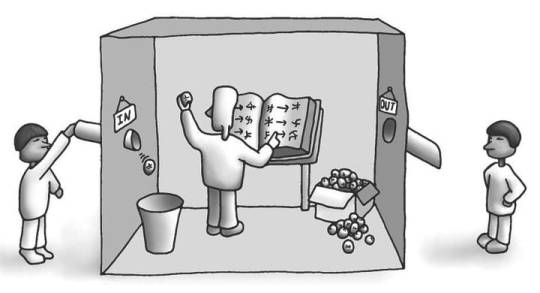
GPT-3 is a world away from the kinds of linguistic A.I. that existed at the time Searle was writing. However, the question of understanding is as thorny as ever.
“This is a very controversial domain of questioning, as I’m sure you’re aware, because there’s so many differing opinions on whether, in general, language models … would ever have [true] understanding,” said OpenAI’s Sandhini Agarwal. “If you ask me about GPT-3 right now, it performs very well sometimes, but not very well at other times. There is this randomness in a way about how meaningful the output might seem to you. Sometimes you might be wowed by the output, and sometimes the output will just be nonsensical. Given that, right now in my opinion … GPT-3 doesn’t appear to have understanding.”
An added twist on the Chinese Room experiment today is that GPT-3 is not programmed at every step by a small team of researchers. It’s a massive model that’s been trained on an enormous dataset consisting of, well, the internet. This means that it can pick up inferences and biases that might be encoded into text found online. You’ve heard the expression that you’re an average of the five people you surround yourself with? Well, GPT-3 was trained on almost unfathomable amounts of text data from multiple sources, including books, Wikipedia, and other articles. From this, it learns to predict the next word in any sequence by scouring its training data to see word combinations used before. This can have unintended consequences.
Feeding the stochastic parrots
This challenge with large language models was first highlighted in a groundbreaking paper on the subject of so-called stochastic parrots. A stochastic parrot — a term coined by the authors, who included among their ranks the former co-lead of Google’s ethical A.I. team, Timnit Gebru — refers to a large language model that “haphazardly [stitches] together sequences of linguistic forms it has observed in its vast training data, according to probabilistic information about how they combine, but without any reference to meaning.”
“Having been trained on a big portion of the internet, it’s important to acknowledge that it will carry some of its biases,” Albert Gozzi, another GPT-3 user, told Digital Trends. “I know the OpenAI team is working hard on mitigating this in a few different ways, but I’d expect this to be an issue for [some] time to come.”
OpenAI’s countermeasures to defend against bias include a toxicity filter, which filters out certain language or topics. OpenAI is also working on ways to integrate human feedback in order to be able to specify which areas not to stray into. In addition, the team controls access to the tool so that certain negative uses of the tool will not be granted access.
“One of the reasons perhaps you haven’t seen like too many of these malicious users is because we do have an intensive review process internally,” Agarwal said. “The way we work is that every time you want to use GPT-3 in a product that would actually be deployed, you have to go through a process where a team — like, a team of humans — actually reviews how you want to use it. … Then, based on making sure that it is not something malicious, you will be granted access.”
Some of this is challenging, however — not least because bias isn’t always a clear-cut case of using certain words. Jervis notes that, at times, his GPT-3 rent messages can “tend towards stereotypical gender [or] class assumptions.” Left unattended, it might assume the subject’s gender identity on a rent letter, based on their family role or job. This may not be the most grievous example of A.I. bias, but it highlights what happens when large amounts of data are ingested and then probabilistically reassembled in a language model.
“Bias and the potential for explicit returns absolutely exist and require effort from developers to avoid,” Tyler Lastovich said. “OpenAI does flag potentially toxic results, but ultimately it does add a liability customers have to think hard about before putting the model into production. A specifically difficult edge case to develop around is the model’s propensity to lie — as it has no concept of true or false information.”
Language models and the future of A.I.
Nine months after its debut, GPT-3 is certainly living up to its billing as a game changer. What once was purely potential has shown itself to be potential realized. The number of intriguing use cases for GPT-3 highlights how a text-generating A.I. is a whole lot more versatile than that description might suggest.

Not that it’s the new kid on the block these days. Earlier this year, GPT-3 was overtaken as the biggest language model. Google Brain debuted a new language model with some 1.6 trillion parameters, making it nine times the size of OpenAI’s offering. Nor is this likely to be the end of the road for language models. These are extremely powerful tools — with the potential to be transformative to society, potentially for better and for worse.
Challenges certainly exist with these technologies, and they’re ones that companies like OpenAI, independent researchers, and others, must continue to address. But taken as a whole, it’s hard to argue that language models are not turning to be one of the most interesting and important frontiers of artificial intelligence research.
Who would’ve thought text generators could be so profoundly important? Welcome to the future of artificial intelligence.
1 note
·
View note
Note
You have such great insights on the text where JKR goes (purposefully) vague. Would love your thoughts on That Kiss in DH - what was Ginnys intention? How does Harry feel about it? Is Ron justified? It’s such a great scene to read.
BIG disclaimer: This is a hotly-debated topic, and there will never be a clear-cut answer. To me, the kiss scene in DH is very sexually suggestive and layered with clues that Ginny intended to sleep with him -- but if you feel otherwise, that's fine too :)
With that in mind, here is my interpretation. But first, here is the passage in question (DH, chapter 7, p. 115-116):
Ginny looked up into Harry’s face, took a deep breath, and said, “Happy seventeenth.”
“Yeah . . . thanks.”
She was looking at him steadily; he, however, found it difficult to look back at her; it was like gazing into a brilliant light.
“Nice view,” he said feebly, pointing toward the window. She ignored this. He could not blame her.
“I couldn’t think what to get you,” she said.
“You didn’t have to get me anything.”
She disregarded this too.
“I didn’t know what would be useful. Nothing too big, because you wouldn’t be able to take it with you.”
He chanced a glance at her. She was not tearful; that was one of the many wonderful things about Ginny, she was rarely weepy. He had sometimes thought that having six brothers must have toughened her up.
She took a step closer to him. “So then I thought, I’d like you to have something to remember me by, you know, if you meet some veela when you’re off doing whatever you’re doing.”
“I think dating opportunities are going to be pretty thin on the ground, to be honest.”
“There’s the silver lining I’ve been looking for,” she whispered, and then she was kissing him as she had never kissed him before, and Harry was kissing her back, and it was blissful oblivion, better than firewhisky; she was the only real thing in the world, Ginny, the feel of her, one hand at her back and one in her long, sweetsmelling hair —
The door banged open behind them and they jumped apart.
Ok. So... Ginny literally pulled Harry into her room and offered to “give him something.”

Even without considering that Ginevra is likely derived from either Arthurian mythology (Guinevere) or references to a juniper bush (and that one is a doozy!), I think JKR is giving us a little tongue-in-cheek allusion to what Ginny actually wants to give. ((And yes, I know that virginity is a social construct... but in this context, that's missing the point.))
Classic literature and various world mythologies alike are riddled with references to virginity as a gift. Regardless of how you feel about JKR, you have to admit she’s extremely well-educated and meticulous. With that in mind, re-read this scene closely. Ginny never once says the words “gift” or “present" -- and imo, this is 100% intentional. No one walks away from reading this scene without the inference that Ginny’s “giving him a birthday gift.” JKR wants the reader to make that leap and infer what Ginny meant; by admitting Ginny’s giving him a gift, you’ve already made that connection... and by thinking of this scene as an interrupted attempt at giving said gift, you’re reaching the conclusions that JKR (within the limitations of a YA series) intended.
But even if you think all of that is nonsense, let’s focus on what happens in that scene as opposed to what doesn’t. Would Ginny (who canonically snogged Harry all around Hogwarts and kissed him in front of everyone) feel a simple farewell kiss would be enough to “remember her by”? Even before she starts “kissing him as she had never kissed him before,” I think the reader can make the leap that she wanted more -- but JKR takes it one step further with Harry’s explicit admission that Ginny’s pursuing greater intention in their physical intimacy.
If that (in of itself) isn’t enough proof, Ron’s reaction hammers the point home -- but this time, try reading this passage through the lens of what Ron not only says, but doesn’t say. Focus on what Ron is really upset about, and you might have a different understanding!
Once he reached the seclusion of the freshly mown lawn, Ron rounded on Harry.
“You ditched her. What are you doing now, messing her around?”
“I’m not messing her around,” said Harry, as Hermione caught up with them.
“Ron —”
But Ron held up a hand to silence her. “She was really cut up when you ended it —”
“So was I. You know why I stopped it, and it wasn’t because I wanted to.”
“Yeah, but you go snogging her now and she’s just going to get her hopes up again —”
“She’s not an idiot, she knows it can’t happen, she’s not expecting us to — to end up married, or —” As he said it, a vivid picture formed in Harry’s mind of Ginny in a white dress, marrying a tall, faceless, and unpleasant stranger. In one spiraling moment it seemed to hit him: Her future was free and unencumbered, whereas his . . . he could see nothing but Voldemort ahead.
“If you keep groping her every chance you get —”
“It won’t happen again,” said Harry harshly. The day was cloudless, but he felt as though the sun had gone in. “Okay?”
Ron looked half resentful, half sheepish; he rocked backward and forward on his feet for a moment, then said, “Right then, well, that’s . . . yeah.”
So... to answer the next part of the question, is Ron’s response justified? Well, it depends what you consider “justified.” In 2019, we read this scene very differently from its intention as written over 12 years ago. Add that to the fact that the events themselves take place in 1997, and I think we’ve got a recipe for people misconstruing Ron’s reaction as that of a brother who has an uncomfortable relationship with his sister’s sexuality.
In re-reading this scene, ask yourself this: Is Ron mad because Harry and Ginny were intimate, or is he concerned about his sister’s feelings? And yeah, go ahead and juxtapose this scene against Ron’s reaction to their kiss in the common room and his chiding over “giving his permission” in HBP (the latter of which Ginny immediately shuts down, but I digress).
I think the answer is clear: Ron knows that Ginny has feelings for Harry, and he doesn’t want to see her get hurt again. He doesn’t want to see them having sex, but he’s not a creepy virtue guardian, either. His strong, visceral reaction tells you quite a lot about his concern for her feelings, especially because Ron immediately relents when Harry promises it won’t happen again. Ron doesn’t see Ginny as a “ruined woman” for having engaged in intimacy with Harry; he just doesn’t want to see her get hurt.
((As an aside, Ron’s use of the word ‘groping’ here and Aunt Muriel’s comments about Ginny’s dress being ‘far too low-cut’ are some of my favorites in this book. I know the UK doesn’t do sexual sports analogies like we do in America, but y’all... do we need more proof they rounded second base??? C’mon!))
To me, the Hinny interactions in the beginning of DH are pretty conclusive proof of what their HBP relationship looked like. They didn’t sleep together (because this “gift” was special and “something to remember her by”)... but the intentional language use also tells me they went further than holding hands.
102 notes
·
View notes
Note
I remember the phrase "sound it out" from school, and I vaguely remember learning something about long & short vowels or such and to (on Between the Lions) but I don't think I ever understood that or paid it any thought since there were so many exceptions. of course, that doesn't mean it didn't do me any good, just that I didn't consciously recognize that it did (perhaps explaining what non-phonic approaches to teaching reading could be contemplated to begin with?)
One non-phonic approach to reading instruction is based on the belief that reading is a process of integration of syntactic, semantic, and graphic (i.e. whole word shape) cues -- in other words, a series of context-based guesses. This model has no allowance at all for the fact that spelling isn’t completely irregular -- as far as it’s concerned, the English alphabet may as well be a logography!
The paper that originally laid out this model (doi:10.1080/19388076709556976) can speak for itself:
Simply stated, the common sense notion I seek here to refute is this: “Reading is a precise process. It involves exact, detailed, sequential perception and identification of letters, words, spelling patterns and larger language units.”
In phonic centered approaches to reading, the preoccupation is with precise letter identification. In word centered approaches, the focus is on word identification. Known words are sight words, precisely named in any setting.
This is not to say that those who have worked diligently in the field of reading are not aware that reading is more than precise, sequential identification. But, the common sense notion, though not adequate, continues to permeate thinking about reading.
Spache presents a word version of this common sense view: “Thus, in its simplest form, reading may be considered a series of word perceptions.”
The teacher's manual of the Lippincott Basic Reading incorporates a letter by letter variant in the justification of its reading approach: “In short, following this program the child learns from the beginning to see words exactly as the most skillful readers see them . . . as whole images of complete words with all their letters.” In place of this misconception, I offer this: “Reading is a selective process. It involves partial use of available minimal language cues selected from perceptual input on the basis of the reader's expectation. As this partial information is processed, tentative decisions are made to be confirmed, rejected or refined as reading progresses.” More simply stated, reading is a psycholinguistic guessing game. It involves an interaction between thought and language. Efficient reading does not result from precise perception and identification of all elements, but from skill in selecting the fewest, most productive cues necessary to produce guesses which are right the first time.
The argument in favor of this position is... a handful of case studies of reading errors made by young children! (And some Chomskyist stuff that I don’t care to work through.) And Ken Goodman, the author of the paper quoted above and one of the major proponents of ‘whole-language theory’, had some studies to back this up:
In a study conducted by Goodman (1965), students in grades 1-3 first read lists of words. Then the children were presented the same words to read in meaningful text. The students made many more errors when they read the words out of context (i.e., when the words were in lists) than they did when the words were read in context. This, of course, is consistent with the hypothesis that reading will be facilitated when semantic-contextual and syntactic-contextual cues are present (i.e., when words are read as part of a text) compared to when words are read devoid of context cues (i.e., when words are read on lists). This finding has been used repeatedly to defend the meaning-emphasis practice of teaching students to recognize words by analyzing syntactic, graphemic-phonemic, and especially semantic cues.
Nicholson (1991) detected several very serious shortcomings in the Goodman (1965) study, however. First, no attention was paid in the Goodman (1965) investigation of the patterns of performance by good and poor readers. In addition, the participants always read the lists followed by reading of the words in context, and thus there was the possibility that the improved performance in moving from list reading to reading in context might reflect some type of practice effect (i.e., the words in context had been seen before, on the lists).
In Nicholson (1991), students once again were asked to process words in lists and in context. In this study, however, the list-context order was manipulated such that some participants read the lists first and others read the words in context first. Moreover, the study included systematic analysis of reading as a function of the grade of participants and their reading abilities relative to other students (i.e., good, average, weak). The outcomes in this study were anything but consistent with Goodman's (1965) results:
- Some readers did benefit from reading the words in the sentence context -- namely, poor readers at each age level and average 6- and 7-year-olds. - In context, a positive effect on reading was obtained in sentence context for good 6-year-old readers and average 8-year-olds only when reading words in sentence contexts followed reading words in lists, consistent with the practice effect explanation of the original Goodman (1965) finding. - There was no positive effect derived from reading words in context for good 7- and 8-year-old readers. Indeed, when the 8-year-old good readers did sentence-context reading first, they did better on reading of the words in list format.
Oops!
In very simple terms: how do you prompt a student who’s struggling with a word -- “Sound it out!” or “Context clues!” (The teachers I had always said clues instead of cues; I don’t know if that was because children would be more likely to know the former word or if someone misread it somewhere in the chain of transmission.) And there are a few problems with that:
- No attention is paid to the process of encoding. Even if treating words as logograms whose readings are to be inferred from context works to teach children to read (it doesn’t), how are they supposed to learn to write? (At the height of whole-language theory’s influence, some states banned public schools from buying spelling books.)
- What happens if you hit a proper noun? Take the following sentence: “Notably, Ross' classification does not support the ☃☃☃☃ of the Tsouic languages, instead considering the Southern Tsouic languages of Kanakanavu and Saaroa to be a separate branch.” Context cues let you extract meaning from this sentence without knowing the reading of ☃☃☃☃, but if you have to read it aloud and you can’t sound things out, you’ll hit “Kanakanavu” and produce garble. (You might still be wrong even if you can sound it out, because stress is unwritten and English words aren’t marked for which rule-set to use -- consider the words alveolar and maraschino -- but there’s a difference between being wrong and producing garble. Garble will probably accurately represent the cues, including the vague, impressionistic shape of the word, but a stress or rule-set error will at least convey the spelling. Buegehti for Buttigieg is a good example of garble -- you have the word-shape cues (starts with Bu, most of the letters are there) and the semantic cues (weird surname from the periphery of Europe; I assume Buegehti is pseudo-Finnish), but it’s not even close, and probably unrecoverable without context. (So contextual information isn’t totally useless.)
- Even if the relevant actors were willing to accept lack of attention to spelling and inability to decode phonetic information that context won’t help you with in order to get gains in reading ability... there are no gains.
But, as things do, whole-language theory got a lot wackier from there. Its proponents started referencing Chomsky’s language instinct to posit a reading instinct, which, the theory went, would lead children to automatically acquire reading with no instruction necessary (except highly technical facilitation was still considered necessary, because if schoolteachers aren’t essential, what’s the point?); claiming that phonics actually impeded literacy; attacking opponents of their theory as part of a far-right conspiracy to suppress teachers’ freedom and destroy public education; calling whole-language education a ‘revolution’ that would lead to true liberation and model the egalitarian society of the future; and so on.
For example, Shafer 1998:
Over the years, various writers, politicians, and media sources have taken aim at whole language, vilifying its motives and misrepresenting its goals. While many of the attacks have come from a lamentable ignorance on the part of T.V. reporters and talk show hosts, evidence exists that a portion of it has been carefully orchestrated by conservatives who clearly seem threatened by the implications of a whole language curriculum. Indeed, the list of writers who have opposed whole language initiatives reads like a who's who of conservative pundits. William Bennett, Phyllis Schlafly, Cal Thomas, and Chester Finn have all written articles deriding whole language, despite its overwhelming acceptance among academic organizations and respected scholars.
Many theories have been offered as to why whole language has become so partisan and acrimonious - and why conservatives in particular seem threatened by its humanistic objectives. What seems glaringly clear, in the end, is that whole language - with its caveat for student liberation and control - scares people who want to maintain a hierarchical, top-down approach to learning. The threat of whole language, at least from my perspective, lies in its bold challenge to traditional icons and time-honored practices. Some teachers feel intimidated by the notion that their way is not the only way - that their favorite authors shouldn't be their students' favorite authors.
When students cease to be receptacles of information and begin generating their own ideas, they occasionally formulate theories that are disconcerting to those who want to maintain "authority" in the classroom. Thus, the recent controversy over teaching a literary canon and classes in western civilization helps illustrate the result of whole language - where students question rather than absorb - and where learning comes to be a very personal, reflective activity. "To study," argues Paulo Freire, "is not to consume ideas, but to create and recreate them" (4).
(On the same page: “It seems clear that people learn best when they are progressing from whole to part so that they understand the importance of correctness and the viability of certain non-standard dialects in certain settings.” First, what the fuck is this supposed to mean? And second, I can’t see something like “progressing from whole to part” without having flashbacks to the polemics against Hegel from one of my philosophy professors -- the direction of progression and the concomitant assignment of more basic status to that which one progresses from, he said, was what distinguished Hegelian from analytic philosophy, and the Hegelian progression from whole to part underlay all the most prominent horrors of the 20th century. It was hard enough to quibble with that then, but it gets harder every time I see someone try to shore up nonsense with that ‘Hegelian’ formula.)
Edelsky 1993 (doi:10.2307/3587486):
Whole language (WL) is, first of all, a perspective-in-practice, anchored in a vision of an equitable, democratic, diverse society. A WL perspective highlights theoretical and philosophical notions about language and language learning, knowledge, and reality. In a WL perspective, language is an exquisite human tool for making (not finding) meaning. The WL view is that what people learn when they learn a language is not separate parts (words, sounds, sentences) but a supersystem of social practices whose conventions and systematicity both constrain and liberate. And the way people acquire that system or are acquired by it (Gee, 1990) is not through doing exercises so that they can really use it later but rather by actually using it as best they can with others who are using it with them, showing them how it works and what it is for (Smith, 1981). ...
Appropriating the label, the jargon, or the typical materials and activities of WL without taking on the liberatory (and therefore status-quo-disrupting) political vision, and without adopting a WL theoretical perspective, is a sure way to prevent genuine change.
And from the sewer of journalism, Metcalf 2002:
Why the infatuation with testing? For its most conservative enthusiasts, testing makes sense as a lone solution to school failure because, they insist, adequate resources are already in place, and only the threat of exposure and censure is necessary for schools to succeed. Moreover, among those who style themselves "compassionate conservatives," education has become a sentimental and, all things considered, cheap way to talk about equalizing opportunity without committing to substantial income redistribution. Liberal faddishness, not chronic underfunding of poorer schools or child poverty itself, is blamed for underachievement: "Child-centered" education, "progressive" education or "whole language"--each has been singled out as a social menace that can be vanquished only by applying a more rational, results-oriented and business-minded approach to public education. ...
Why is the same conservative constituency that loves testing even more moonstruck by phonics? For starters, phonics is traditional and rote--the pupil begins by sounding out letters, then works through vocabulary drills, then short passages using the learned vocabulary. Furthermore, to teach phonics you need a textbook and usually a series of items--worksheets, tests, teacher's editions--that constitute an elaborate purchase for a school district and a profitable product line for a publisher. In addition, heavily scripted phonics programs are routinely marketed as compensation for bad teachers. (What's not mentioned is that they often repel, and even drive out, good teachers.) Finally, as Gerald Coles, author of Reading Lessons: The Debate Over Literacy, points out, "Phonics is a way of thinking about illiteracy that doesn't involve thinking about larger social injustices. To cure illiteracy, presumably all children need is a new set of textbooks."
Whole-language theory isn’t as popular now as it used to be. But the underlying Lysenkoist tendency has taken strong root in L2 education, which is why most of the people in my second-year German class couldn’t properly decline the definite article.
Sometimes you just have to drill.
15 notes
·
View notes